Welcome to CamundaCon New York 2024!
We hope you’re as pumped up as we are for CamundaCon New York 2024, which kicks off in mere hours! Just like at the previous CamundaCon in Berlin, we’ll be bringing you the latest updates from the event live as they’re happening. Be sure to check back frequently as we’ll be updating this post throughout the day.
If you couldn’t join in person in NYC, it’s free to join online—so you can still catch all the sessions! Just register at the link below, check out the agenda and make sure you don’t miss anything. We’ll see you there, whether online or in person!
Here with us already, before the opening keynote? We’ve got a sneak peak behind the curtain for of things getting set up from yesterday. Excited for the main event to begin at 9am!
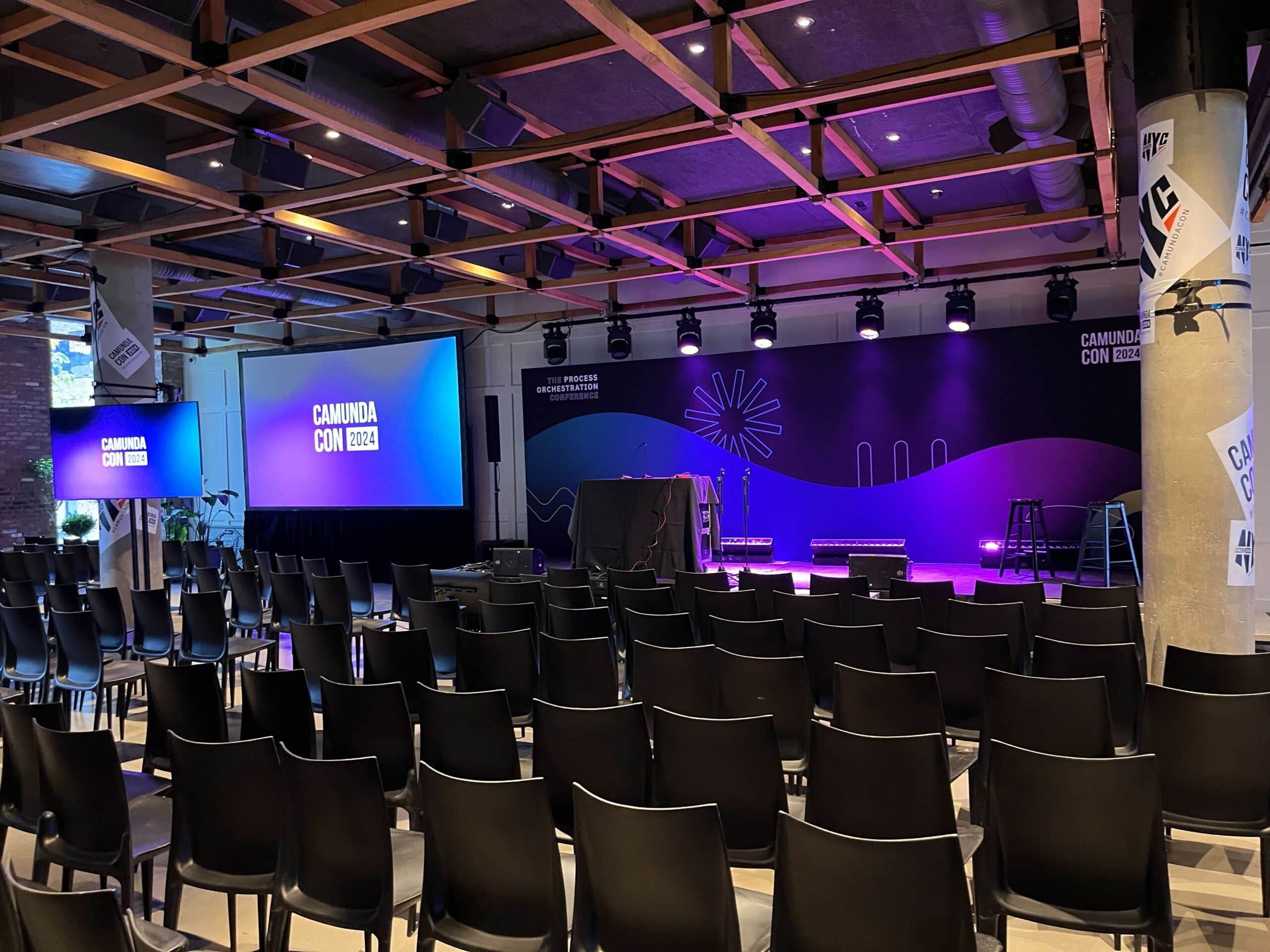
We’re almost there! The countdown is on!
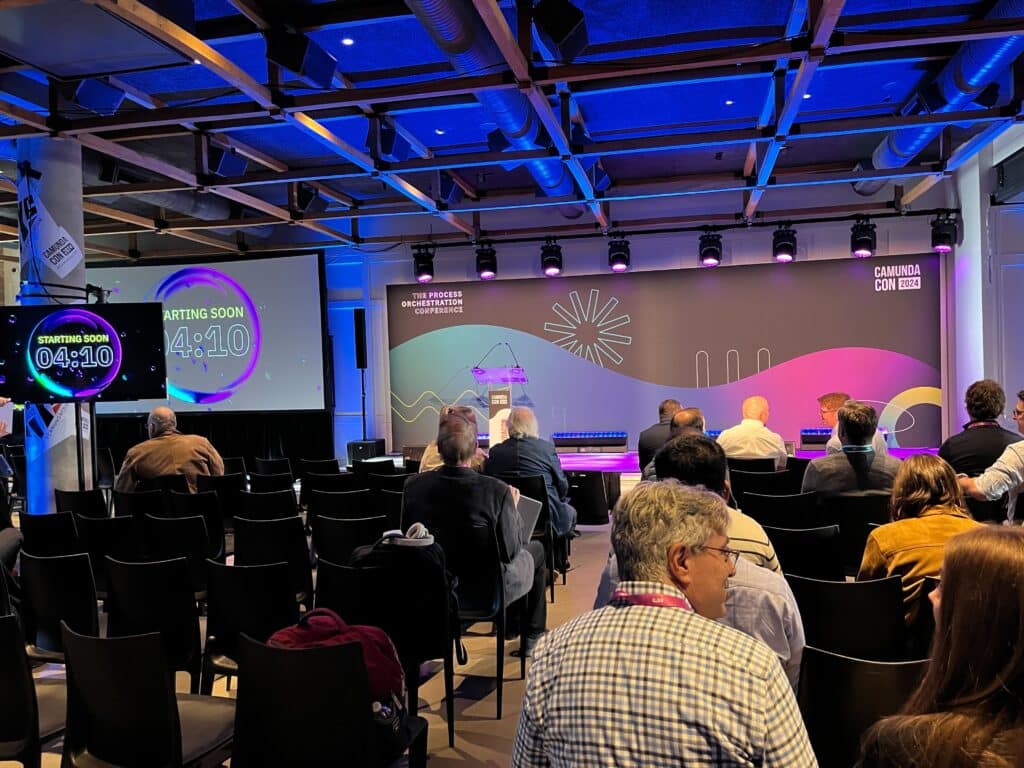
Behind the scenes – sneak peek!
Our behind the scenes coverage gives you a great view into the event from a new perspective. Those of you online have the professional view of course, but even those here in person can catch our team (like Mary here) welcoming everyone here with a look behind the curtain.
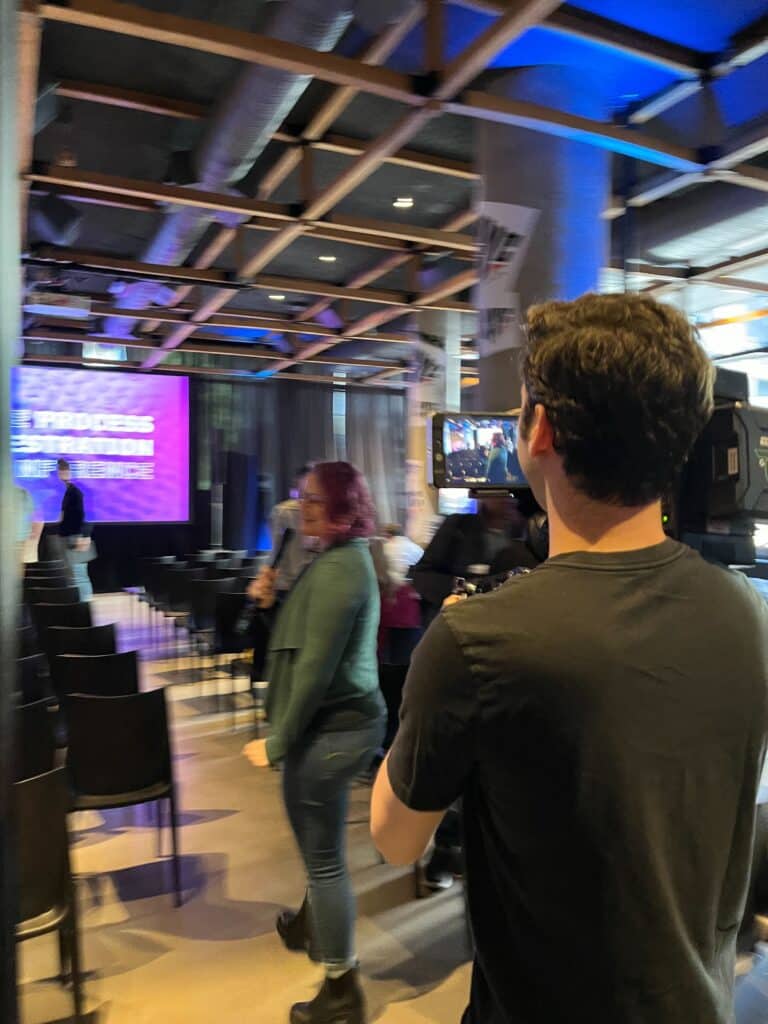
Zee was also here to welcome everyone with a smile 🙂
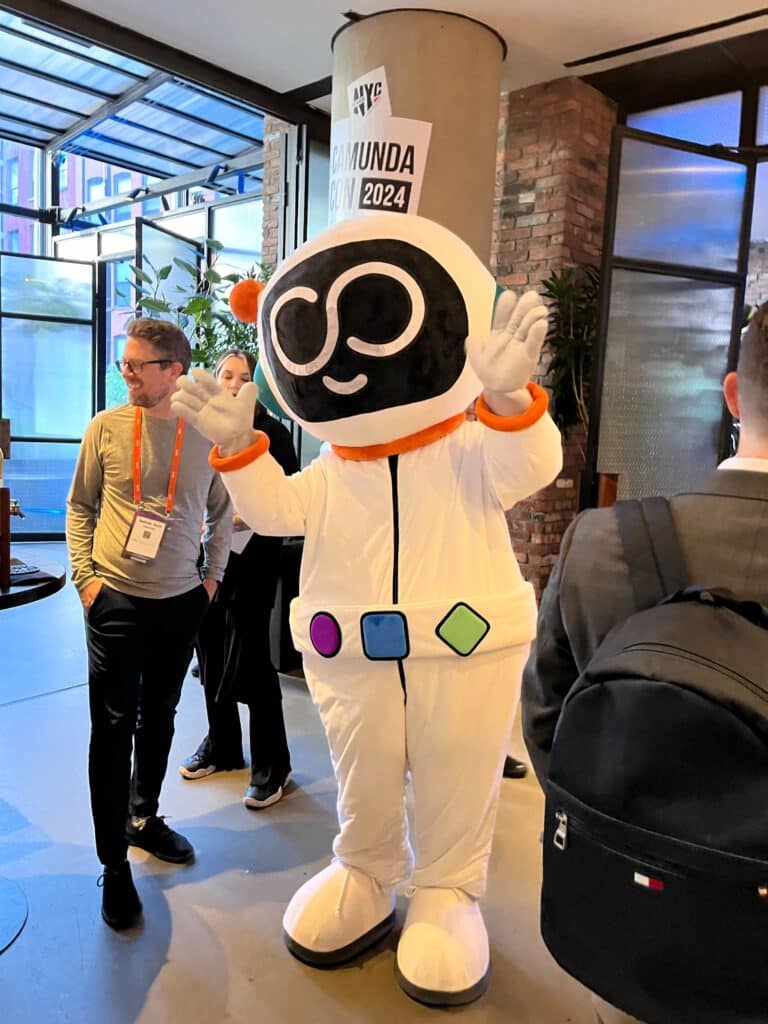
Welcome!

Camunda’s Amy Johnston welcomed everyone to CamundaCon New York 2024! After a brief explanation of the Selfie Screen (tag your selfies with #camundacon and #selfie to join!), how to navigate all four tracks both in person and online that will be taking place over the next two days. Amy also shared highlights including key speakers and events (like lunch, of course, and our behind the scenes videos), our AMA and sponsor booths, industry roundtables, and the fantastic aftershow coming up tonight.
Next up, she welcomed Camunda CEO Jakob Freund to the stage.
Opening Keynote by Jakob Freund
Waves of AI
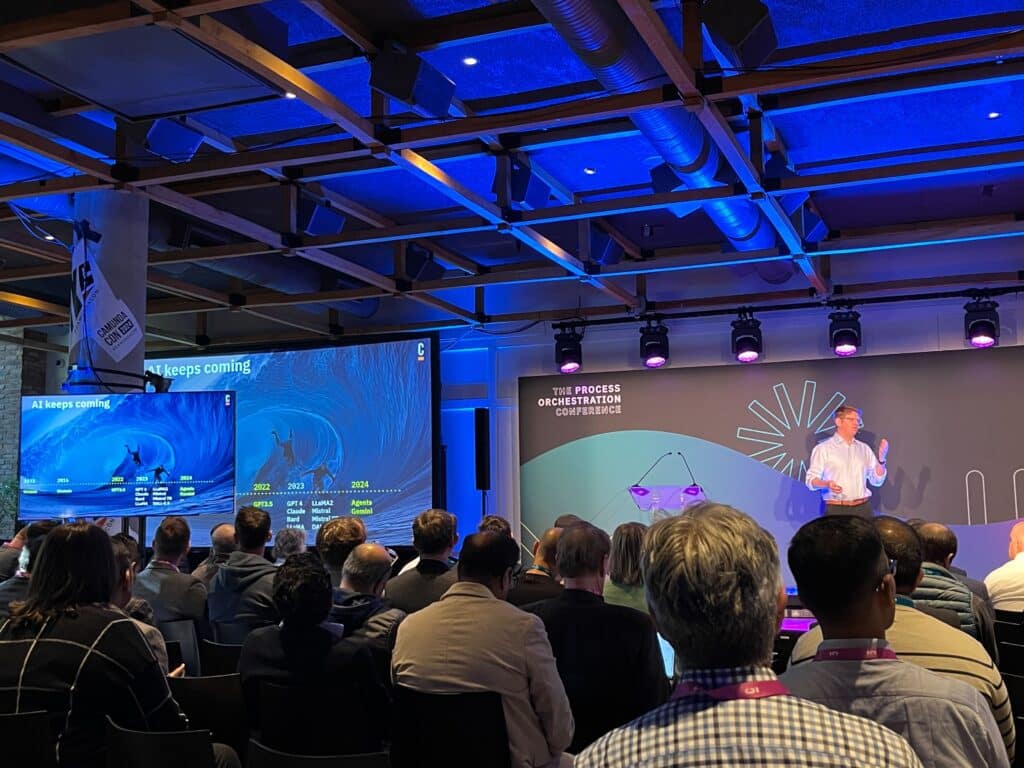
Camunda CEO and co-founder took the stage next and welcomed everyone to the conference. He introduced this moment as the start of a new chapter, both for Camunda and (not coincidentally) for the whole industry. Describing the waves of AI, which are coming faster than ever, he asked us all the question: How do you take action when things are changing so quickly?
Jakob talked about how you can’t just throw AI in to anything and hope it will work – not only will that not deliver optimal value, in some cases it’s actually the wrong solution entirely. This is, in fact, what happened with early waves of automation, where companies adopted things like RPA and point solutions for local automations while feeling under pressure to automate quickly. This may have seemed like a win at first, but in the end it only adds to technical debt and ultimately makes the spaghetti architecture even messier.
How can you tame all this complexity? This is where process orchestration comes in. You don’t need to throw away everything you’ve built, but you do need to tame it and bring it all together so you can understand it in the present and make changes for the future.
Jakob explored an example with Deutche Telecom, showcasing how they started with some initial successes in areas like RPA but ran into a wall of limitations as their automation architecture grew into a “spaghetti bot.” Process orchestration with Camunda helped them get their arms around it and drive further innovation for the future.
We’ve seen, as Jakob noted, how Forrester and Gartner have recognized this change in the market as well. Change is coming, and we all need to be ready to take action – the right way.
Introducing RPA and IDP
Camunda is in a great place to adapt to this changing environment, as both Gartner and Forrester place orchestration at the center of where things are going. Jakob noted that Camunda is the “uncontested leader in end to end process orchestration” in the market today, with composability and flexibility at our core. Today, Jakob also introduced that Camunda will be introducing RPA and IDP into our platform.
Jakob emphasized that no, Camunda is not trying to compete as a pure-play RPA vendor. But in some ways, RPA is table stakes these days. We’ve had customers who just want access basic capability and have even built it themselves. So we thought, why don’t we provide this for you, right out of the box?

Camunda has been investing in a number of accelerators to help organizations move faster and more effectively with process orchestration. The Camunda Marketplace has been growing, and is now filled not only with Connectors but also process blueprints that can help jumpstart your own process creation. There are also solutions created by our amazing partners like Cognizant and EY.
Process Orchestration for SAP
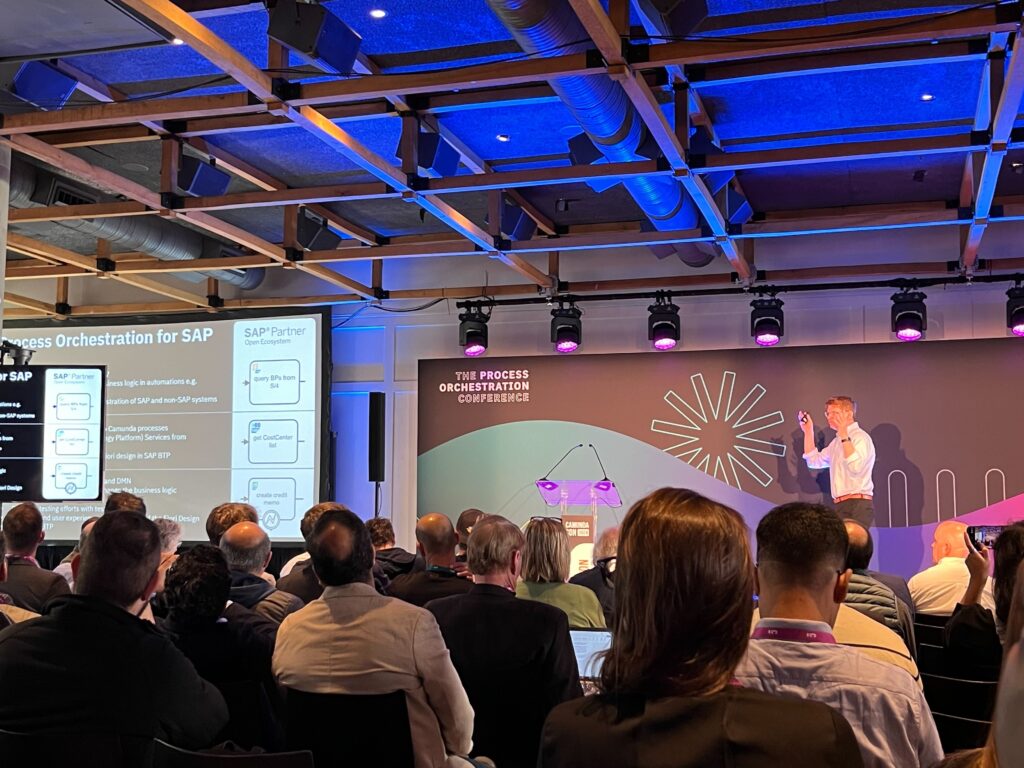
One exciting new development is an integration with SAP. SAP is an incredibly popular solution and this new integration makes it easy to use Camunda to orchestrate your SAP processes, without having to move them out of SAP. It’s good to be composable! There will be more information on this at another talk later today, so be sure to tune in for more details.
AI-Enhanced Process Orchestration
How does Camunda look at AI-enhanced Process Orchestration? Camunda is driving towards what Jakob called “autonomous orchestration with guardrails,” thoughtfully combining how to be deterministic with ad hoc execution. This includes things today like Camunda Co-Pilot as well as coming changes like agentic AI. Camunda aims to continue to be the premier platform for process orchestration and automation.
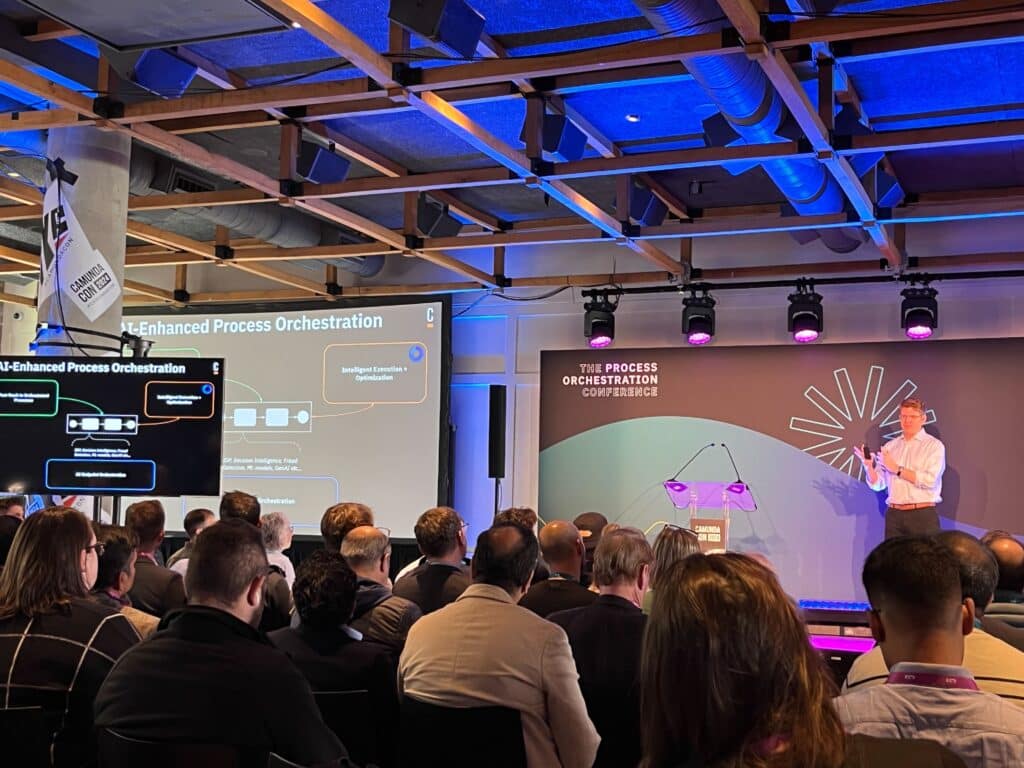
“Talk is cheap, let’s hear from customers”
Those were Jakob’s words as he brought speakers from leading companies to the stage. Davish Shah from Atlassian, Ed Perez from BNY and Sudipto Dey from Cigna chatted with Jakob about the business impact of process orchestration, and how they have made use of centers of excellence, SaaS, APIs, microservices and more. Each speaker has a dedicated session coming up, by the way, so check out the agenda and don’t miss them!
Jakob then welcomed everyone to CamundaCon again and encouraged everyone to learn, network and have fun. Be sure to check out Jakob’s full talk as well as this blog post for more details on everything here.
The Future of Business Orchestration an Automation: Beyond RPA, BPA Low Code
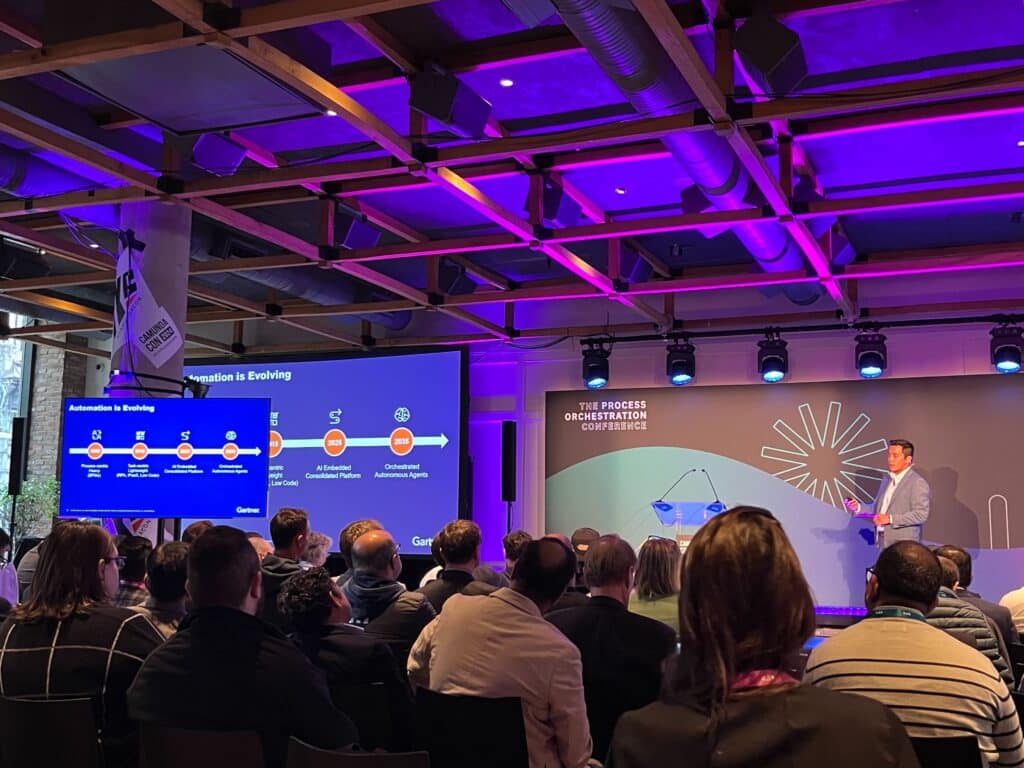
Next up, Arthur Villa, Senior Director Analyst at Gartner, took the main stage. He explained that automation has clearly recognized value but is hard to recognize correctly. Arthur took us on a brief history of automation, noting that we are now in an era of convergence between automation tools, where tools that once did just one thing (RPA, BPM, etc.) now claim to do a lot more. This convergence, he noted, is important but confusing.
Gartner sees this consolidation as where the market is headed as the platforms in the newly introduced category of Business Orchestration and Automation Technology (BOAT) develop. But it has to be done the right way, and orchestration must be at the center.
Using an example of an automated auto accident response, Arthur demonstrated the complexity and how many different tools or systems might need to be involved to do it right. He shared a survey with over 200 responses from a Gartner webinar showing that orchestration was the overwhelming choice as the key factor companies were focused on.
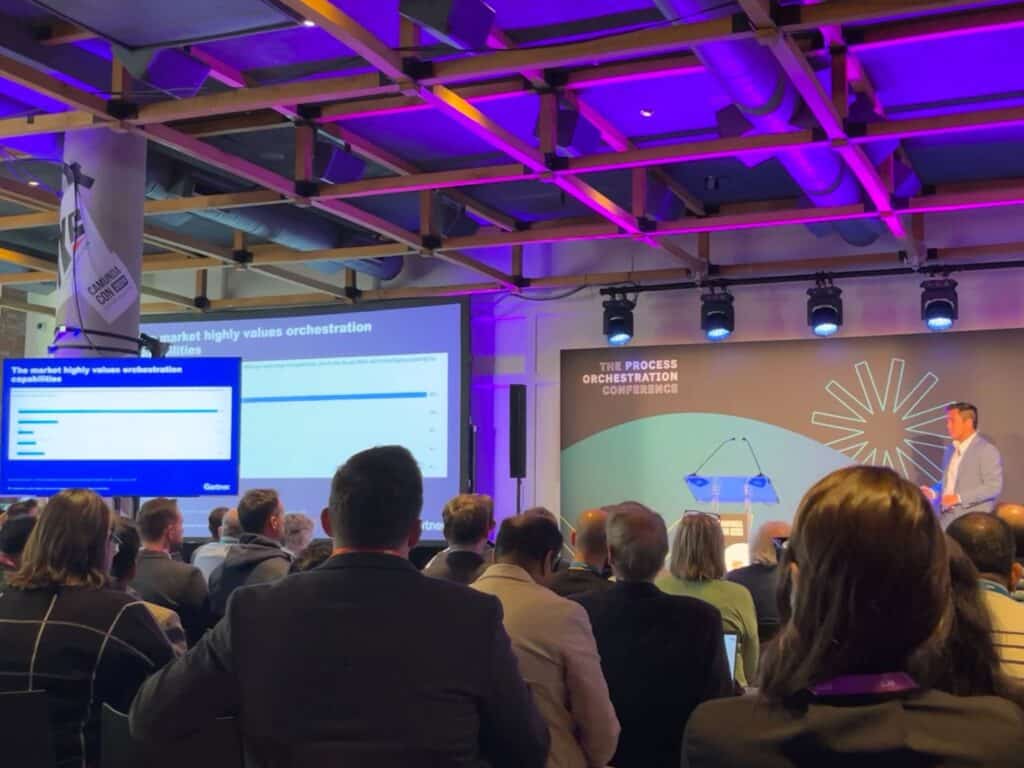
Who needs a BOAT platform? Arthur shared that if you are brand new to automation or have minimal use cases it’s probably a bit much for you, and if you’re already demonstrating automation mastery (estimated at less than 5% of customers based on their hyperautomation maturity model), you are probably getting a lot of unique value from your best of breed approach. But for the vast majority of organizations in the middle, a BOAT platform can provide tremendous value by simplifying your automation and future-proofing your systems. Telling the story of one company’s four year migration journey, Arthur reminded us all to never underestimate the pain of migration.
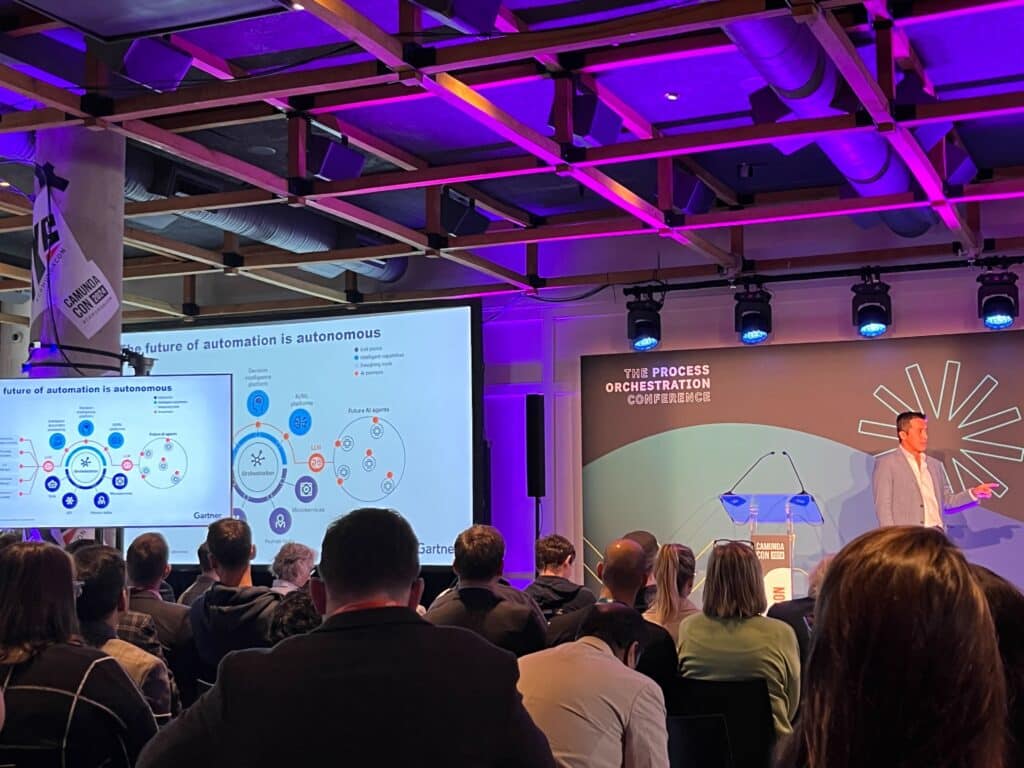
Before opening things up for Q&A, Arthur closed with a message: “The future of automation is autonomous, but it needs to be orchestrated.”
Be sure to catch this full talk on the recording later to see all the details of this talk and hear the full Q&A after.
Maximizing the business impact of process orchestration: What can a CoE do for you?
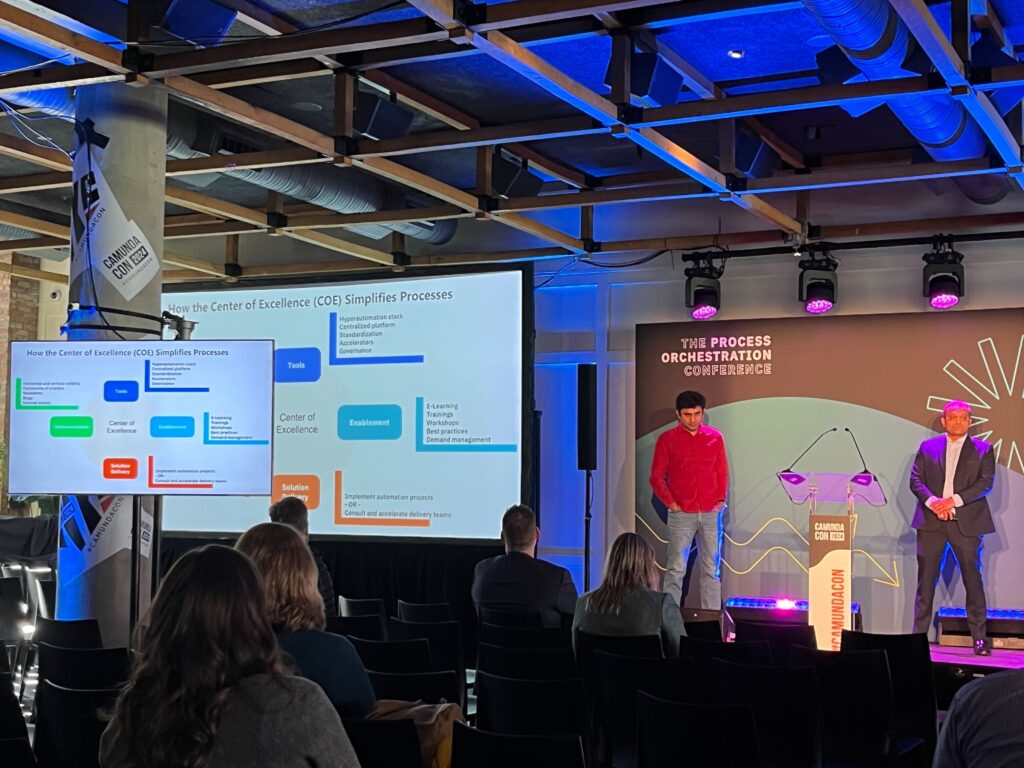
Next on the main stage, Daivish Shah, Intelligent Automation Platform Architect once more joined us, along with Senjam Sarpal, Finance Tech Lead from Atlassian. The talk highlights the way Atlassian built their center of excellence (CoE) with a dedicated team, and how it drives innovation and continuous improvement across the company.
Daivish introduced their Camunda journey, starting back in April 2020 with the initial contract, followed by four large rounds of trainings, with the first high transaction volume application using Camunda launching in November 2021. This thoughtful approach has enabled them to continue growing and scaling, and today Camunda powers 16+ apps, 100M+ decision instances, and 65M+ process instances for Atlassian.
There are four pillars to the center of excellence (CoE) at Atlassian (which you can see in the image above) – communication, tools, enablement, and solution delivery. Careful consideration in terms of how they built up each of these areas and how they work together helps greatly simplify processes across the company.
Senjam stepped in next to talk about the Shoplassian business use case, and how Camunda is used specifically to drive business value. It was fascinating to hear the way the team at Atlassian was able to implement Camunda here.
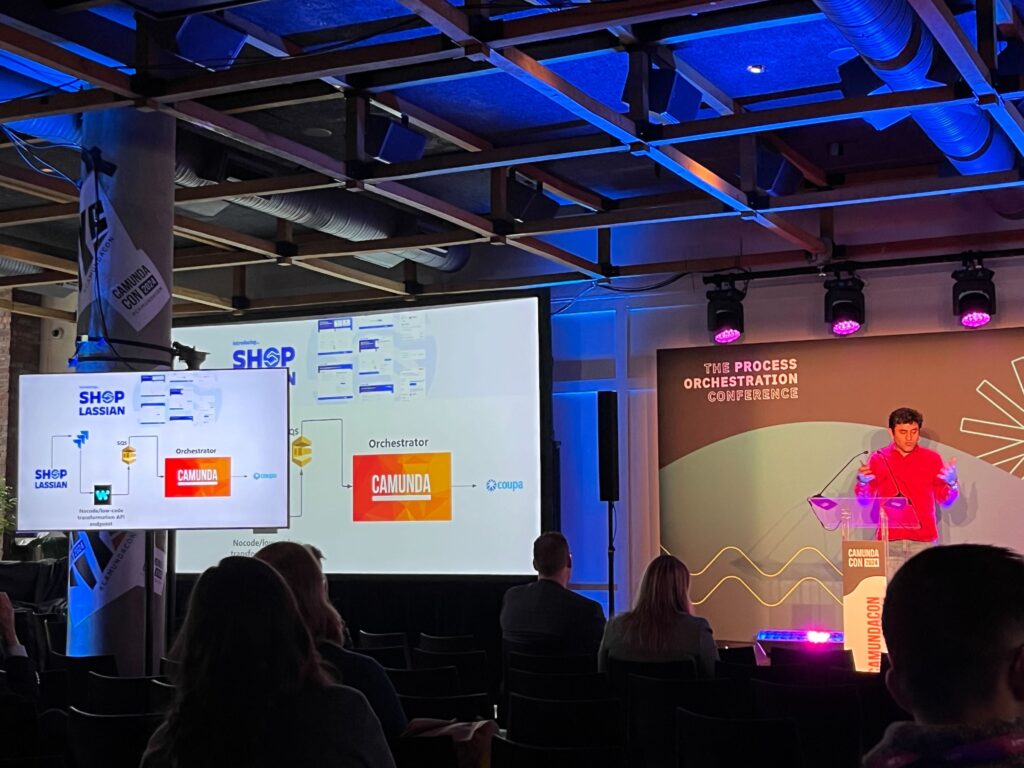
Be sure to watch the full recording for all the details and the Q&A.
British Telecom: Transforming service orchestration with low-code and user-friendly process orchestration
John Wealls, a product owner for Openreach Limited (a subsidiary of BT Group), was on the Orange stage Wednesday morning to discuss how Openreach moved from monoliths to BPMN with the help of Camunda. Himanshu Nagpal, a senior manager of software engineering at British Telecom, joined Wealls online for the presentation.
Why transformation?
Openreach need to overcome product journey lifecycle challenges for supplying fibre broadband to 25 million homes. The previous system could only process 8,000 orders per week. Wealls noted that after partnering with Camunda, Openreach can process 40,000-45,000 orders per week.
Openreach conducted an extensive POC with Camunda beginning in April 2020. Camunda stood out from competitors when it came to design and collaboration and its Modeler, Optimize, and Cockpit UI features. “It offers flexibility without any outages,” Nagpal noted, pointing out this as a significant change from the time-intensity of Openreach’s previous system.
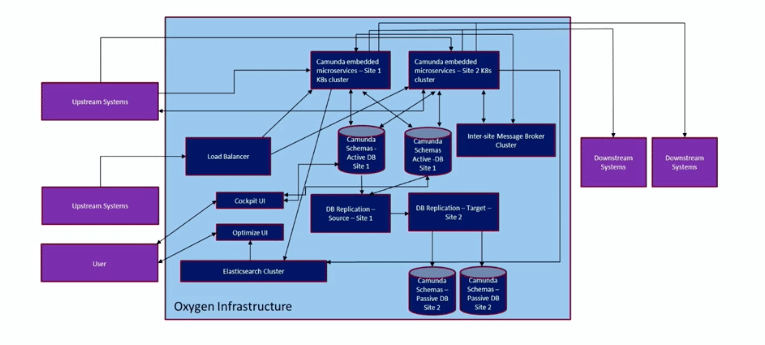
How easy to integrate?
Integration between the Camunda platform and the microservices-based architecture Openreach already had in place was seamless, according to Nagpall. “We now have a highly resilient architecture, communicating with upstream and downstream services.” In nine months and with zero service-impact issues, “and in the challenging days of COVID,” Openreach began agile development and soft-launched their strategic product.
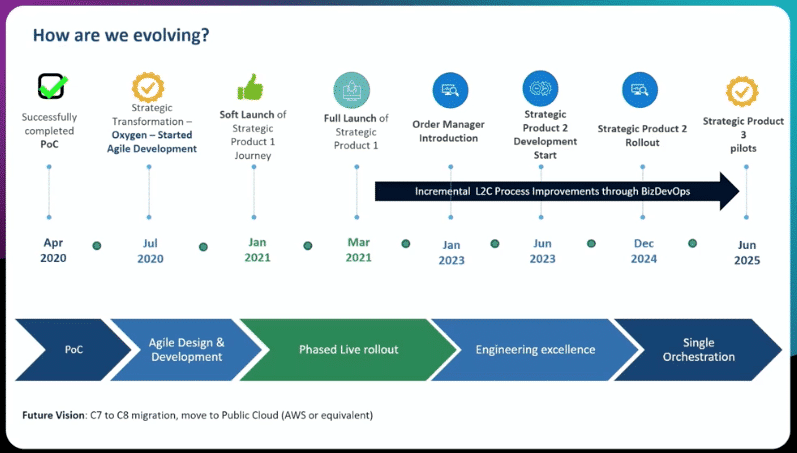
How has BT Group benefited from Camunda?
“We’re faster to market, we’ve streamlined our porcesses, and we have very high availability under deployment,” Wealls said. He added that the real-time analytics provided by Camunda also enables rapid innovation. Financial benefits to Openreach have included enhanced efficiency, 50% reduced infrastructure cost, and again noted that deployments are happening in seconds with no downtime.
One particular use case Wealls highlighted is Openreach’s Order Manager—the tool has reduced multiple microservices for progressing an order to a simple web UI. The end result is that an engineer on the ground can identify a need to request city counsel permits to complete an order, and within seconds, that task is in someone’s desktop queue.
As a result of its increased efficiency and reduced downtime, Openreach has increased its NPS score by 20 percent since working with Camunda.
CamundaCon Hackday
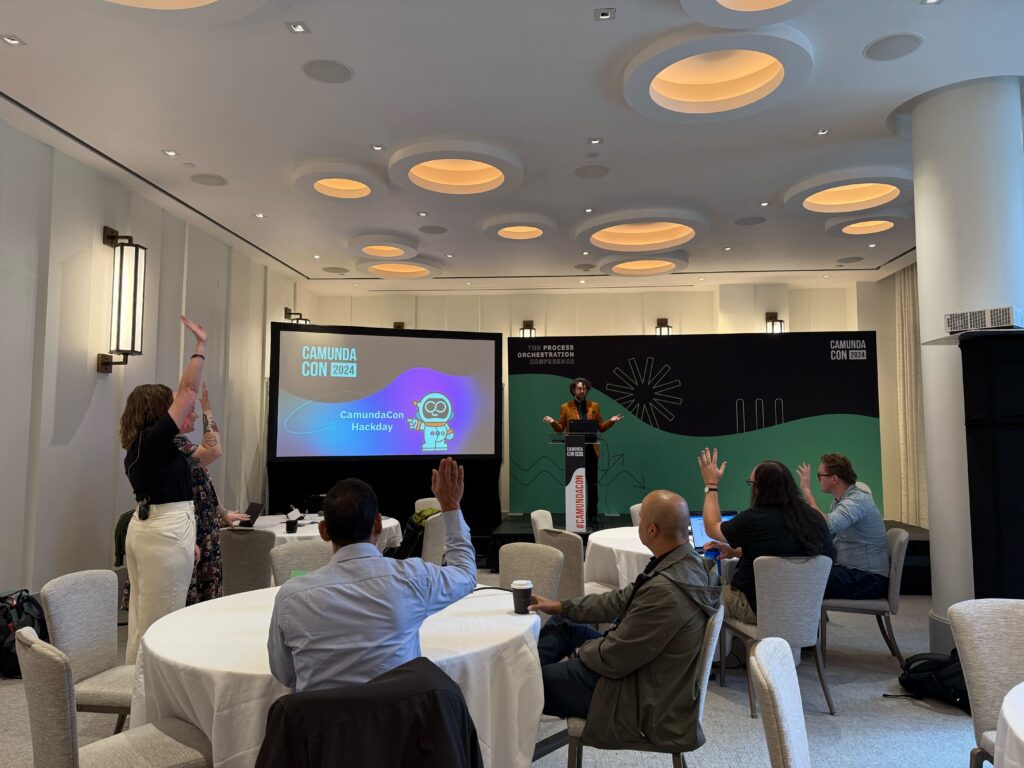
As the first set of talks after the keynote were taking place, we were also kicking off our Hackday upstairs. For our in-person attendees in this room, there a new technical challenge afoot that they will have to solve in just an afternoon. Before the day is out, they will present their solutions to the CamundaCon audience in a dedicated session. This is a always great experience for anyone able to join in person and keep an eye out for updates from the presentations later today.
Lessons in implementing Camunda8 SaaS for Banking
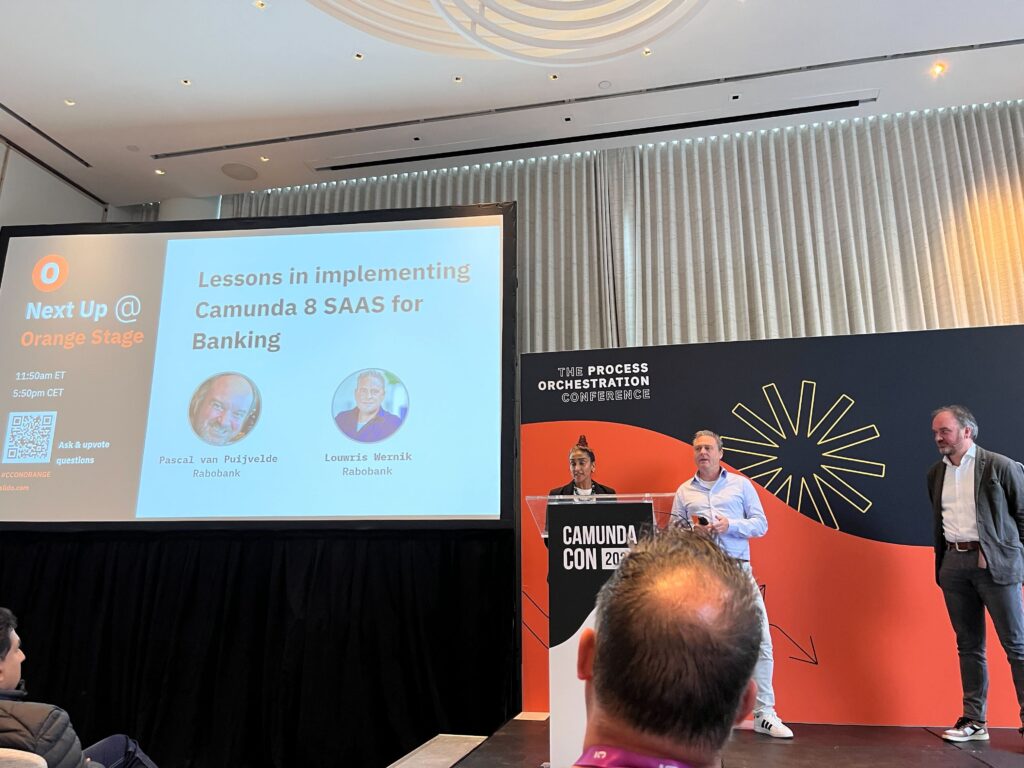
This session opened up with Louwris Wernink, IT Lead Area Accounts, and Pascal van Puijvelde, Lead Business Analyst at Rabobank, a leading cooperative bank in the Netherlands with over 6 million accounts. They focus on consumer banking as well as food and agriculture, and have a large number of youth accounts geared in part towards financial education.
Rabobank’s journey to Camunda began with a new project – how to allow customers to have better overdraft protection. The existing method for orchestrating the process was hard to update (it was directly built into their frontend) and couldn’t meet their needs, as they sought to improve the UX and innovate faster. Pascal explained that this brought them to Camunda, which integrated nicely with their existing tech stack. They onboarded to Camunda 8 SaaS at the beginning of this year.
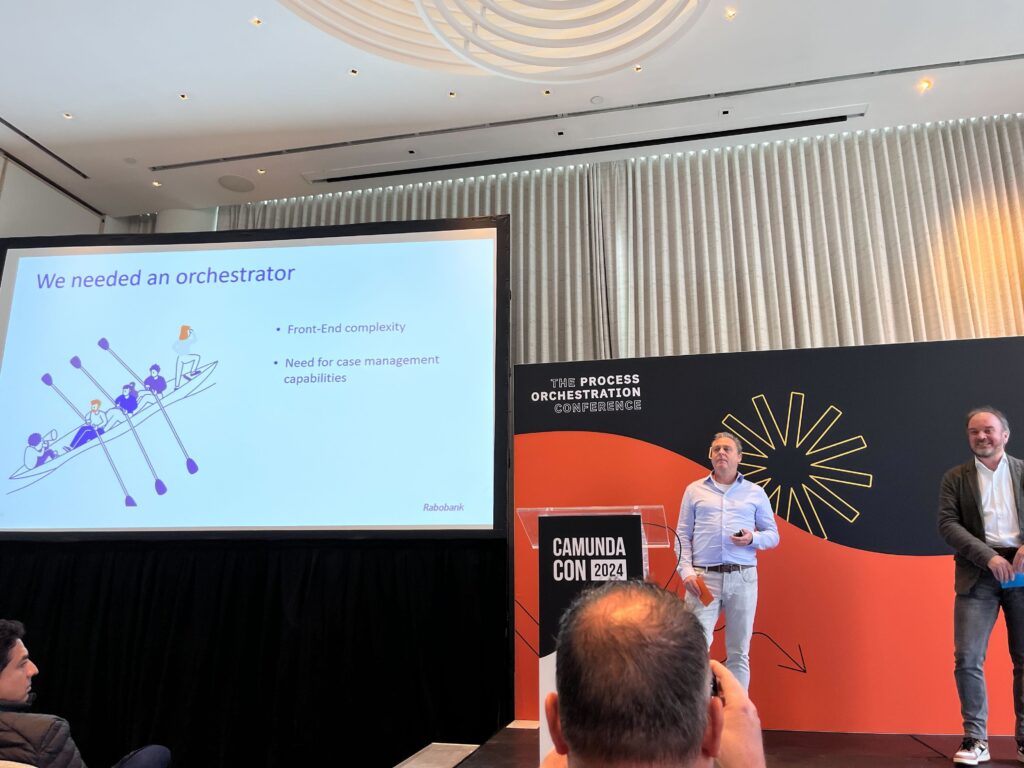
Louwris and Pascal then spoke to some of the things they had to learn to make Camunda work. Both IT and the business stakeholders were new to BPMN, for example. They had also not used SaaS here before, and as a major financial institution, there were a lot of security and privacy regulations they had to ensure compliance with. Ultimately, with the help of a Technical Account Manager and other support from Camunda, they were able to work through their challenges and establish a Center of Excellence that met their needs.
This talk was a fascinating look at the way Rabobank was able to reevaluate their entire process and workflows, learn and train how to use Camunda to create a BPMN-driven, flexible and scalable process for the future, and lean into innovation in a highly regulated industry. Don’t miss the great Q&A at the end, including a well-placed BOAT pun (see if you can catch it).
How process orchestration improved data governance at Walmart
Wilson Gaitan, director of data governance at Sam’s Club (a membership club owned by Walmart), took the Main Stage Wednesday morning in New York to discuss the impact of process orchestration on data governance at the global retail giant.
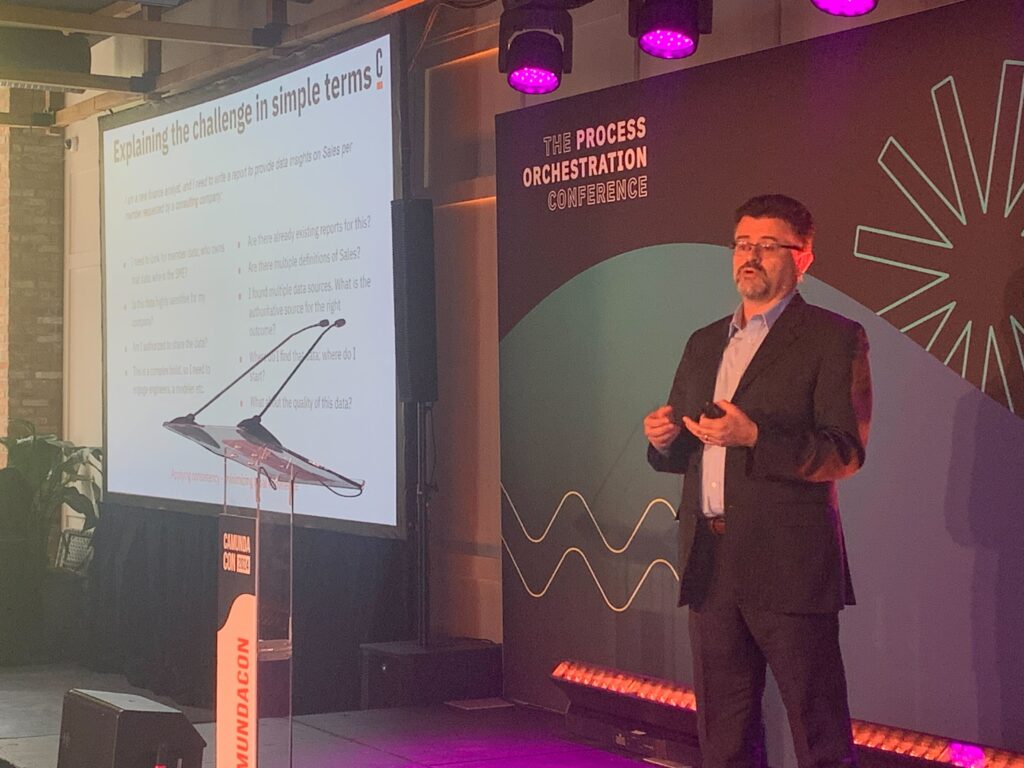
Explain the challenge in simple terms
For Walmart and Sam’s Club, billions and billions of records come in from customers and vendors all over the world. “All of us are very good at delivering data, but what if I need it?” Gaitan pointed out. “How do I find it? When do I get rid of it? There are tons of processes just to make sure data is private. Who’s deleting tax data after seven years?”
Data assets—tables, databases, etc.—have to have someone accountable for them, someone managing them. “How do we know who is responsible for what? Where did this metric come from that you’re trying to hit? Can you trust that number?” Gaitain noted that it’s hard to trust that data unless you have transparency and visibility into the data you’re working with.
Data governance ensures the trustworthiness and currency of data assets. But maintaining the up-to-date-ness of data is an impossible task manually.

“We don’t want people to think that data governance is something you have to do in addition to your day-to-day tasks.” Having a strong process orchestration capability helps the data owner avoid “reactive data governance.” Instead, Gaitan suggested, embed data governance processes into the everyday tasks of data management.
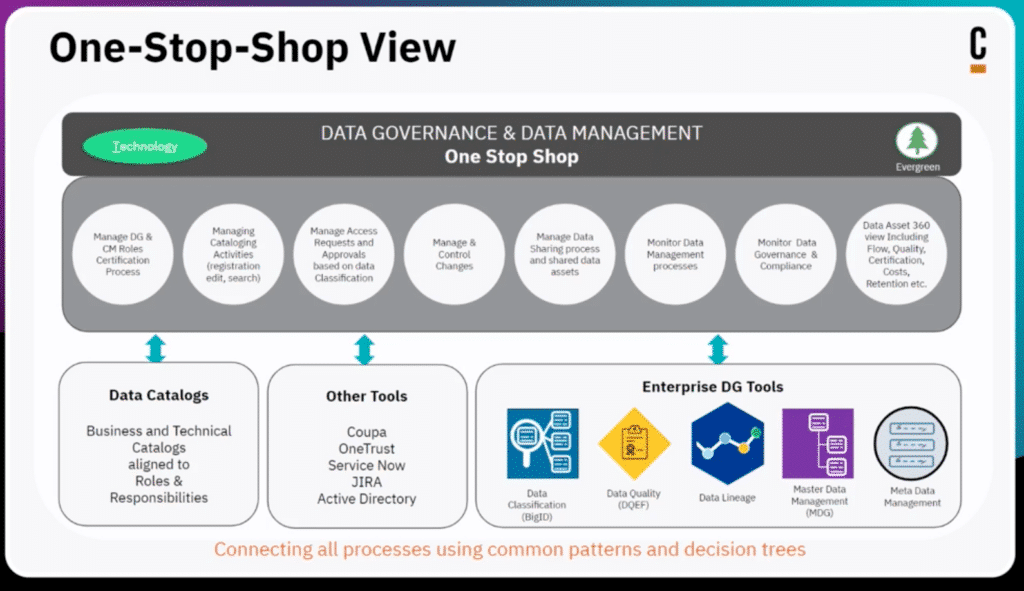
How Camunda is helping with Walmart’s data governance approach
Gaitan wrapped up by covering a few key ways that Camunda is ensuring the scalability and automation of data governance for Sam’s Club:
- Keeping data assets and those responsible for each asset up to date in its processes
- Enforcing good data hygiene
- Offering easy integration with other tools that support data governance and management without reinventing the wheel
- Facilitating visibility into data assets with end-to-end process orchestration
- Providing data for process refinement and reengineering
- Making it easy to change when processes need to evolve
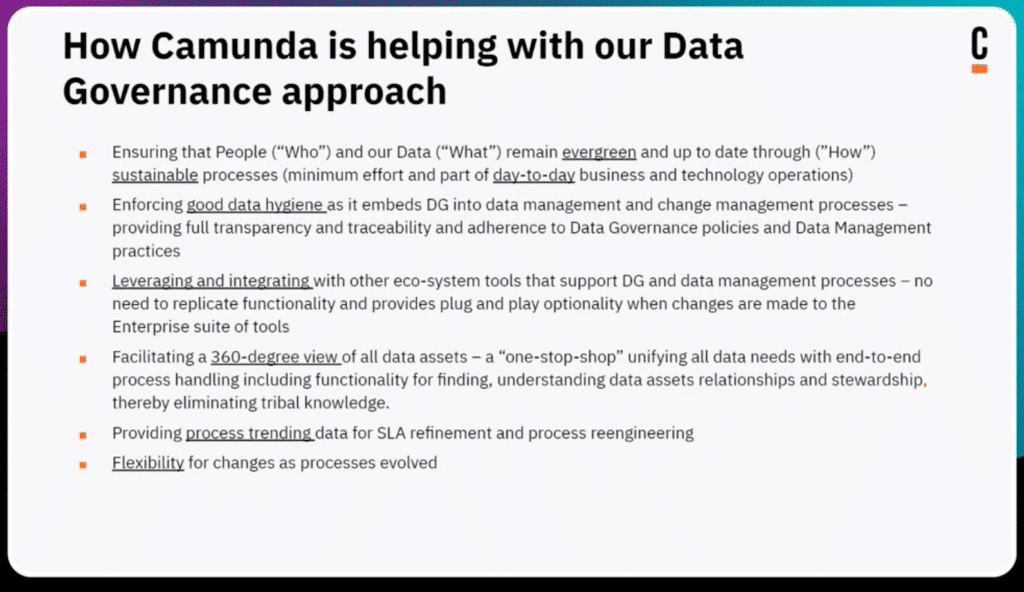
ICYMI
While we weren’t able to cover them live, there have already been two great talks on the Purple Stage that we would be remiss not to mention:
- Camunda: From Zero to Hero: Autoscaling process orchestration with Camunda
Nicolas Pepin-Perrault and Simon Zengerling, Engineering Manager and Engineering Tech Manager at Camunda respectively, led this session on how you can auto scale in Camunda 8, focusing on operational efficiency and sustainability. This kind of scalability is particularly critical for situations where you don’t always know what your requirements are or how they will change over time. Check it out to learn how it works and see a demo in action. - Camunda & Ibo: A hands-on approach to measuring strategic value with top-down process orchestration
How do you determine which metrics are most effective for measuring project value, and how to use process orchestration strategically and capture those metrics? Join Tobias Conz, Senior Product Manager at Camunda and Guido Fischermanns, CEO at ibo GmbH, as they examine the way top-down process orchestration can help both IT and business stakeholders contribute strategically to the business.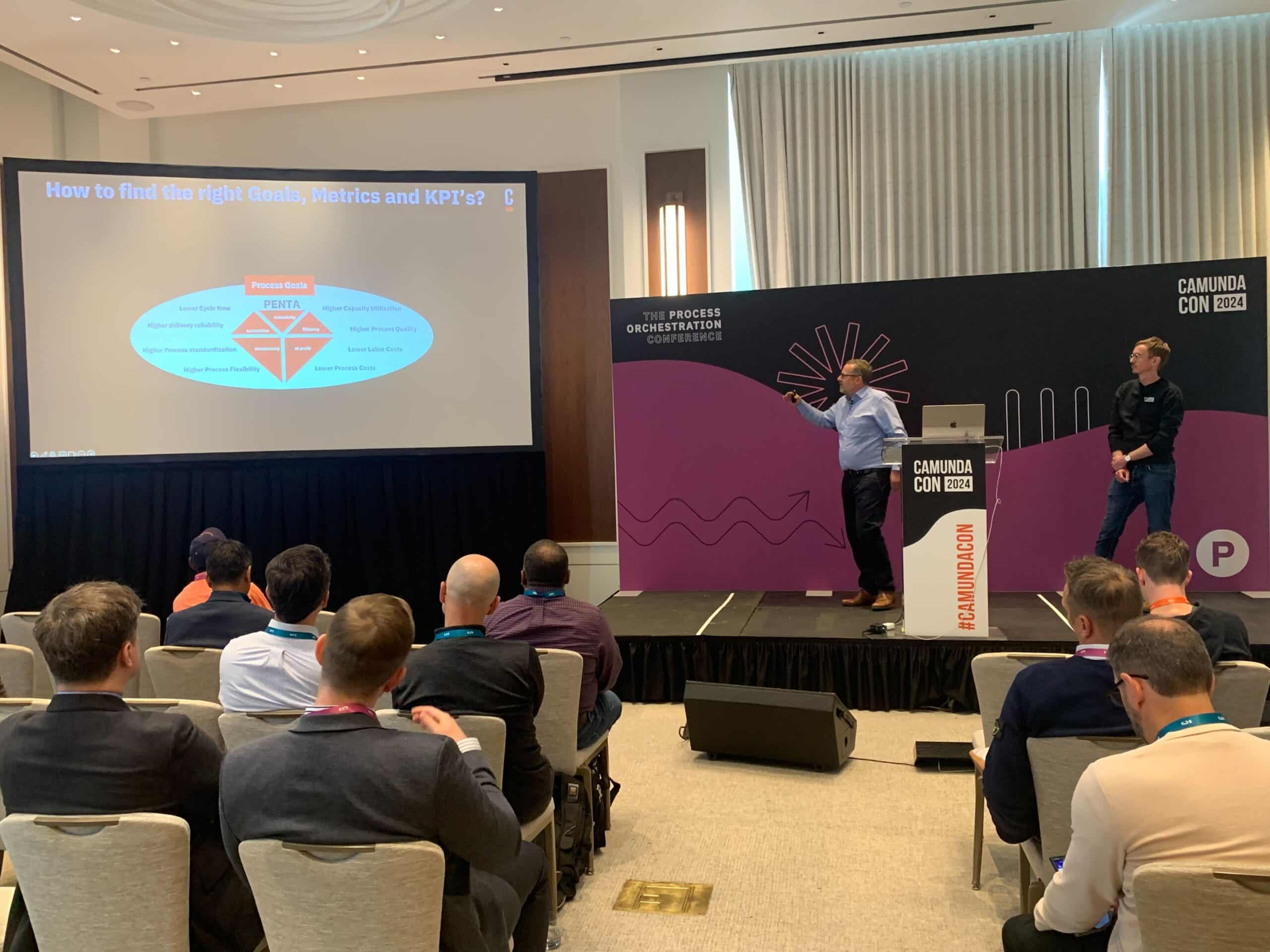
Lunch!
It’s time for lunch here! Those of you attending virtually were able to enjoy another look behind the scenes, and we’ll be back with more coverage soon.

Driving Success in Automation: The Power of Cross-Functional Collaboration and Stakeholder Alignment

We’re back, and in this panel discussion, moderated by Helen Park (Senior GSI Partner Director), an all-star group of leaders assembled on the stage to talk about cross-functional collaboration and alignment. Mike Hastie (Head of Enterprise Architecture at a Major Healthcare Insurer), Bhargav Trivedi (Senior Director, Distinguished Engineer at Capital One), Prashant Gaonkar (VP-Global Strategy and Planning, Enterprise Platforms at Cognizant), Frederic Meier (SVP Sales at Camunda) all had great insights to share.
There was a lot of great conversation about how to get organizational alignment. Frederic spoke to two axis of alignment, one with a well-articulated vision from the C-level that is disseminated across the organization, and another between business and IT. Prashant added that communication is key, people need to understand how it will affect them. Silos get created when people fear a loss of control and when they are not brought into the fold.
Talking about overcoming obstacles, Mike shared a story about how they were able to take an automation project from nothing to production in a few months by communicating well, getting buy-in and doing things the right way. Even though it meant a business team lost its tool for a time, and the implementing team needed to learn a new technology, having a well-understood vision made it work. In the end they were able to measure the economics of what they gained by collaborating on the project and it was a recognized success.
Bhargav mentioned the importance of demonstrating ownership to bring everyone along, and Helen asked how you go about that if you are not leadership yourself? There were a lot of great ideas shared, with Prashant noting that it’s important to understand the needs and objectives of all stakeholders, Frederic emphasizing the importance of communicating business value, and Mike highlighting the benefits of getting that first win with demonstrated value.
Helen closed with a question about predictions for how we will collaborate in 20 years. Bhargav noted how hard it is to predict like this – 20 years ago he would have predicted mainframes would be long gone by now, though they still power financial institutions, and he would never have guessed where mobile technology has gone today. But he did predict that everything would get even more real-time. Prashant shared that he thinks knowledge will be further democratized. Mike talked about how everything will have AI in it but it has to be done right or it won’t really return value, and Frederic mentioned how composable process orchestration can really help operationalize that, so you can use AI when it makes sense and other technology when they make more sense.
All in all it was a fascinating discussion. Check out the recording for the full conversation and the Q&A that followed.
Revitalizing Insurance Processes: Norfolk & Dedham Group’s Migration to Camunda
Over on the Orange Stage, Shashi Ayachitam, IT director at the Norfolk & Dedham Group Insurance, walked us through an architecture redesign—specifically how they migrated from an obsolete BPM tool to Camunda.
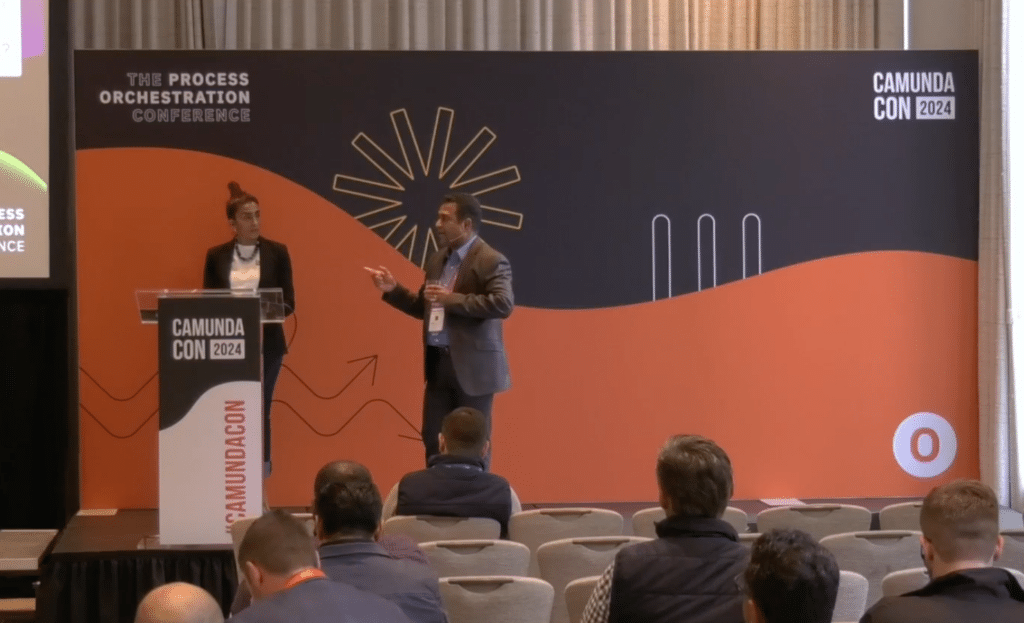
Norfolk & Dedham’s needs
Six months ago, this 200-year-old insurance company went live with a revamp of their claims solution. Their legacy workflow system of about 650 workflows from 2000 had been acquired and then killed with no migration plan in place. Fortunately, because it was an inhouse solution, not customer-facing, Norfolk & Dedham could delay an upgrade until they performed some market research.
Market research into BPM solutions
Norfolk & Dedham looked into several options in the market, such as Adobe Experience Manager and Oracle BPM. “We wanted a nice, decoupled architecture support. Camunda kind of checked all those boxes.” Even while Norfolk & Dedham was on the open-source license, there was no hesitancy from Camunda support.
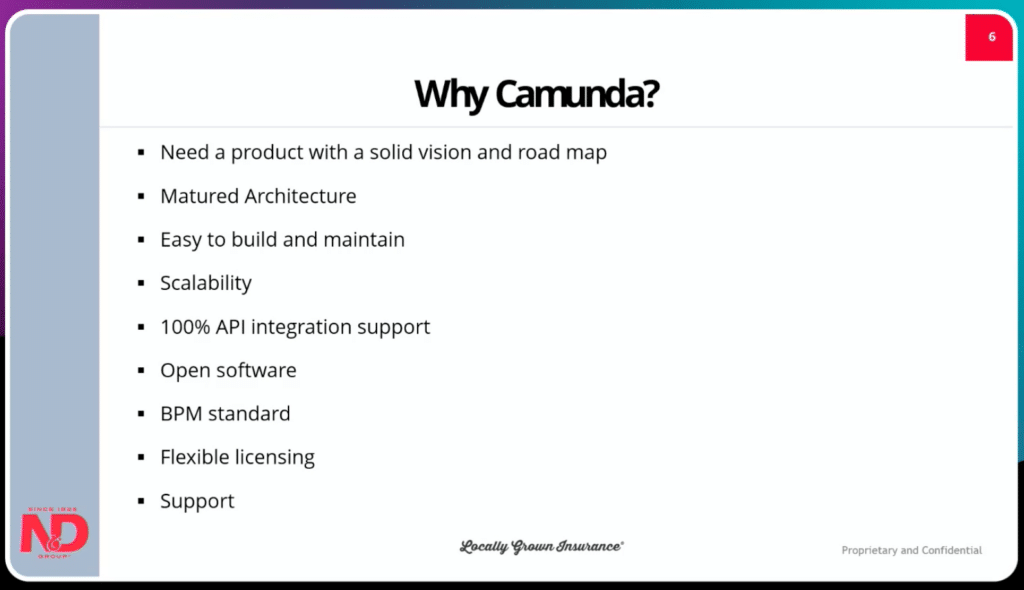
Migration and customization
“Camunda had a great talent for helping us navigate through the whole journey,” Ayachitam said. With Camunda support, Norfolk & Dedham was able to customize Camunda Modeler to best fit their needs. “Every customer has custom requirements, and every customer needs to build something special for how they work.”
Business insights and impacts
Post-migration, their chief claims officer has better access to claims data, which in turn helps answer strategic business questions. “We’ve been able to adjust resources, increasing in this department and moving people in that department. And we’re just touching the bare surface—there’s huge potential beyond how we’re using the data now.” Ayachitam expressed that he’s particularly keen on watching the evolution of the Cockpit UI.
Currently they’re only using it for claims, but they’d like to expand into other departments in 2025. “The goal is to make the entire process more straightforward,” Ayachitam said, “with less handholding by either the policy holder or the agent.”
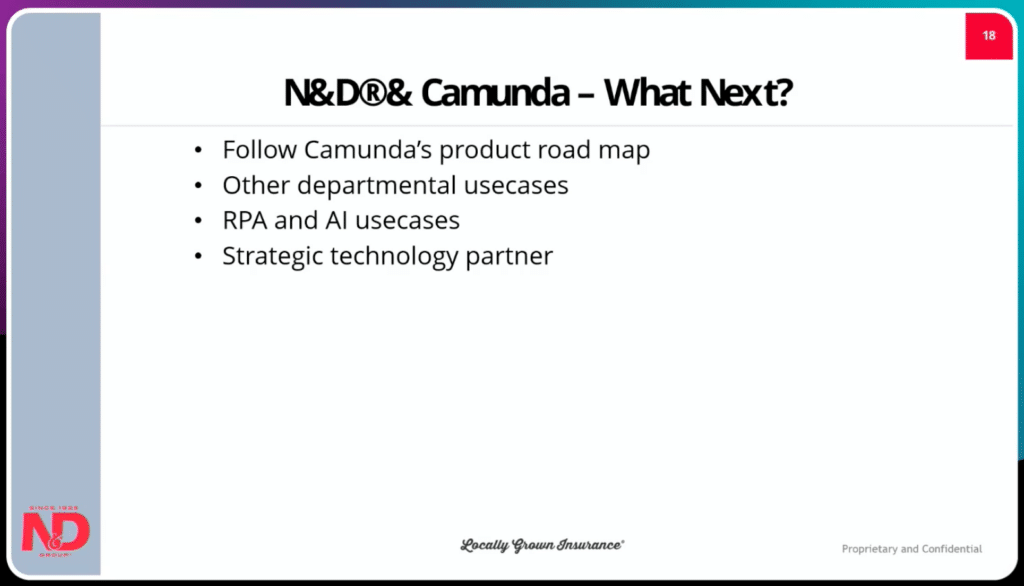
It all comes together: the Unified Camunda 8 REST API and the improved developer experience
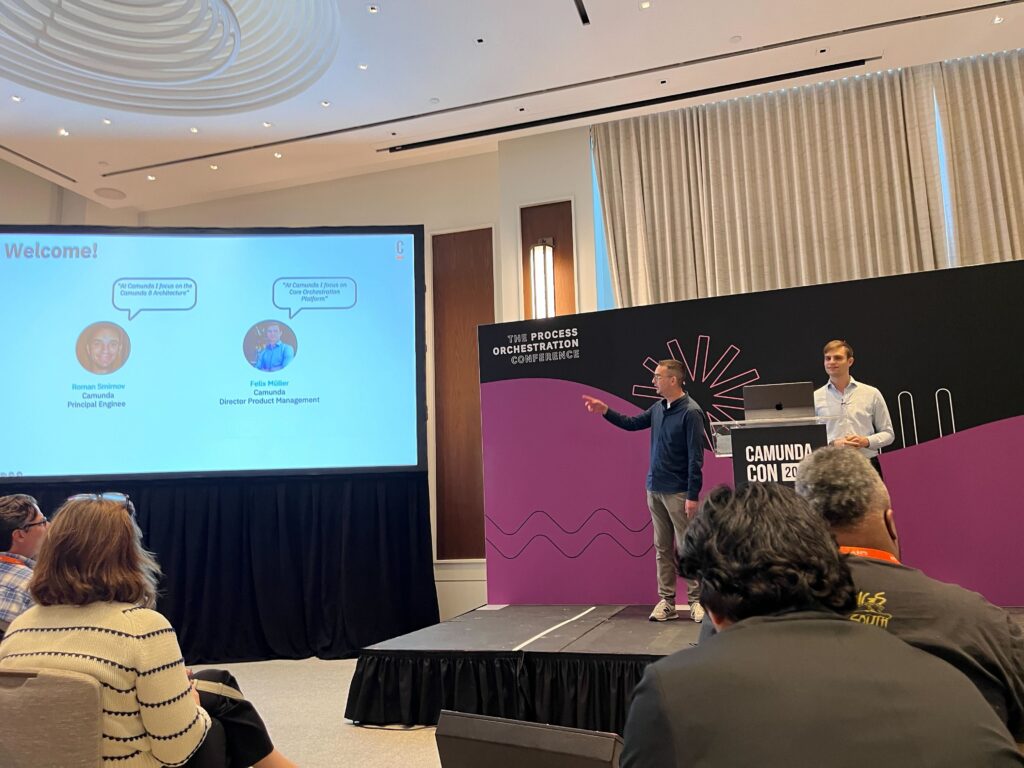
Up on the Purple Stage, Felix Mueller Director of Product Management and Roman Smirnov, Principal Software Engineer at Camunda led a talk about the new unified Camunda 8 REST API and improvements to the developer experience. Roman “quickly” took us through an example process using the previous developer experience. It worked, but… it took some time.
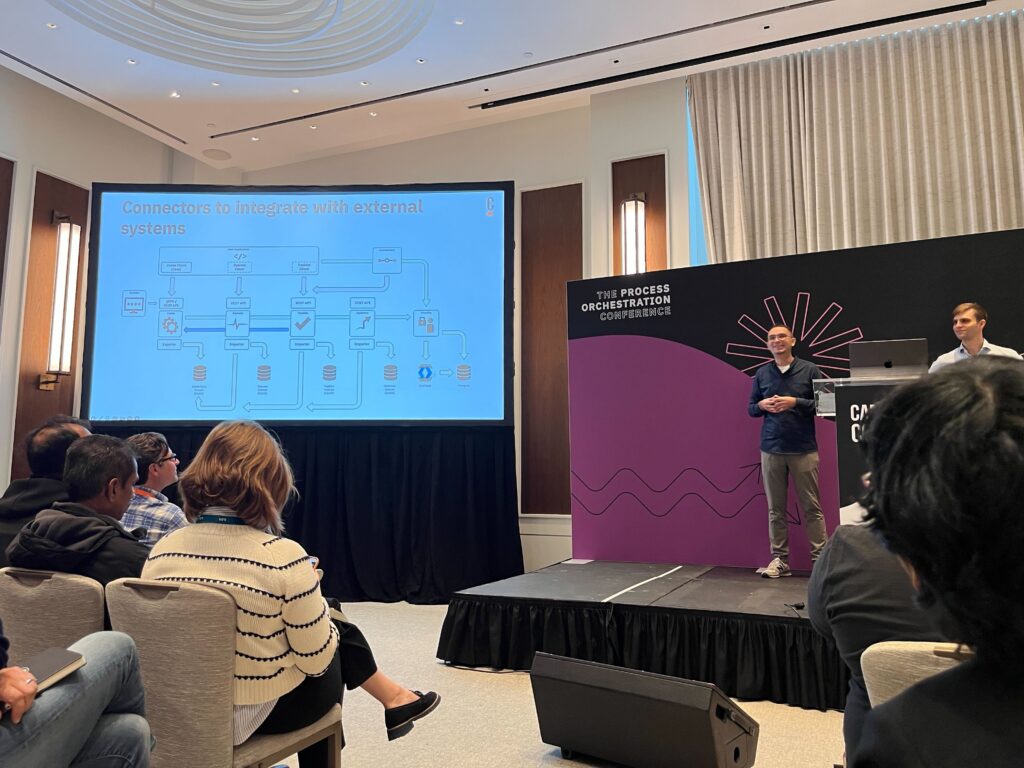
The answer was to develop one streamlined solution. This greatly simplified the process, as Roman showed by taking us through things again. It was a great step-by-step walkthrough of how the new API makes a difference.
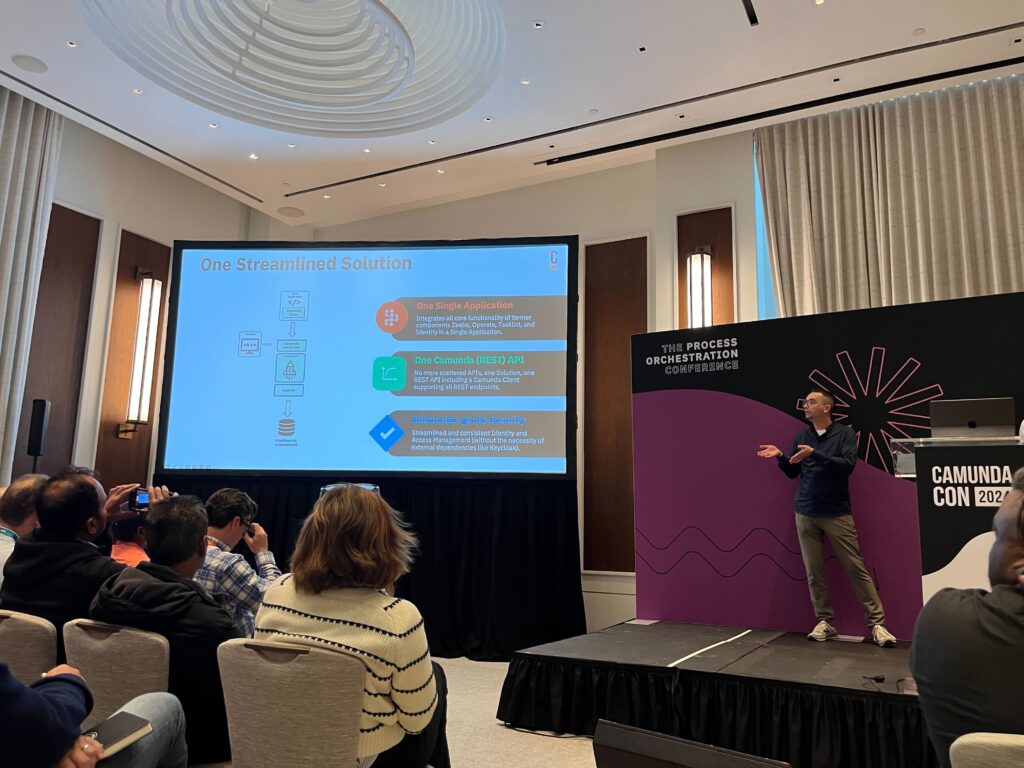
How does this affect me as a user? Felix stepped in next to cover this. He introduced Camunda 8 Run, designed to improve the experience for local development, and then – always dangerous – successfully demonstrated how it worked live.
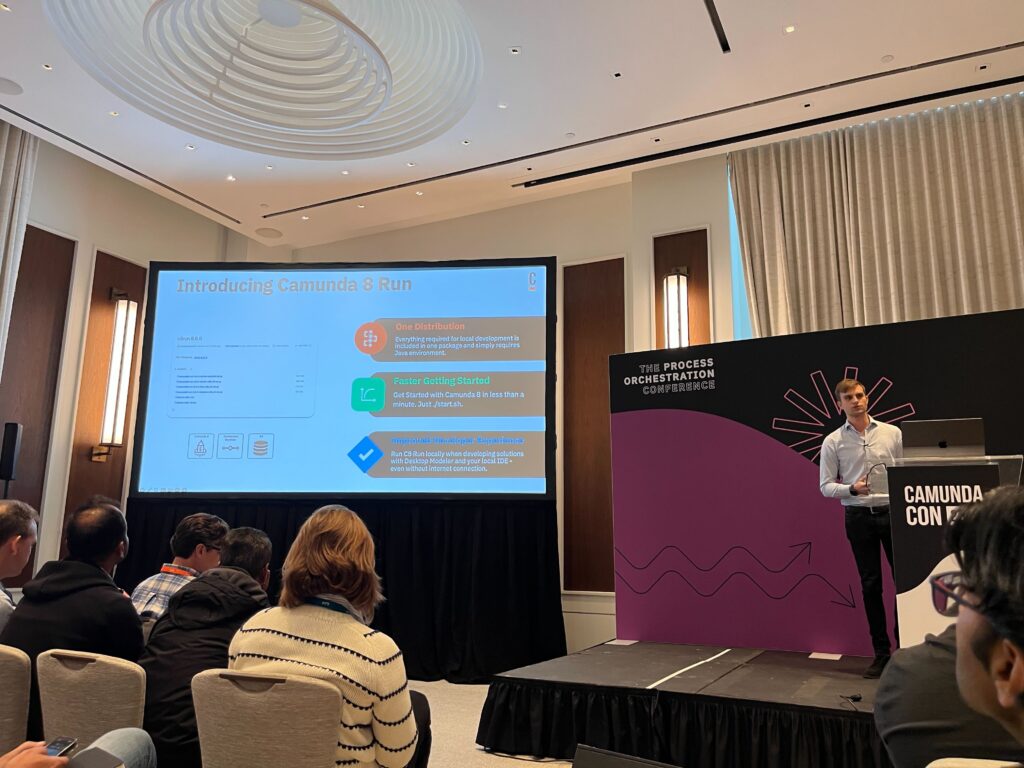
This popular (standing room only!) session gave a really interesting demonstration of some powerful improvements that are now a part of the Camunda developer experience. Felix also previewed the roadmap, and it’s exciting to see where this is all going. Judging by the energy in the room, I wasn’t alone in thinking that.
Intuit: Revolutionizing workflow management at scale for mid-market businesses
Back on the main stage, Yash Agarwal, lead software engineer at Intuit, and Rishabh Surana, senior product manager at Intuit, made a case for the connection between dynamic workflow management and business success.
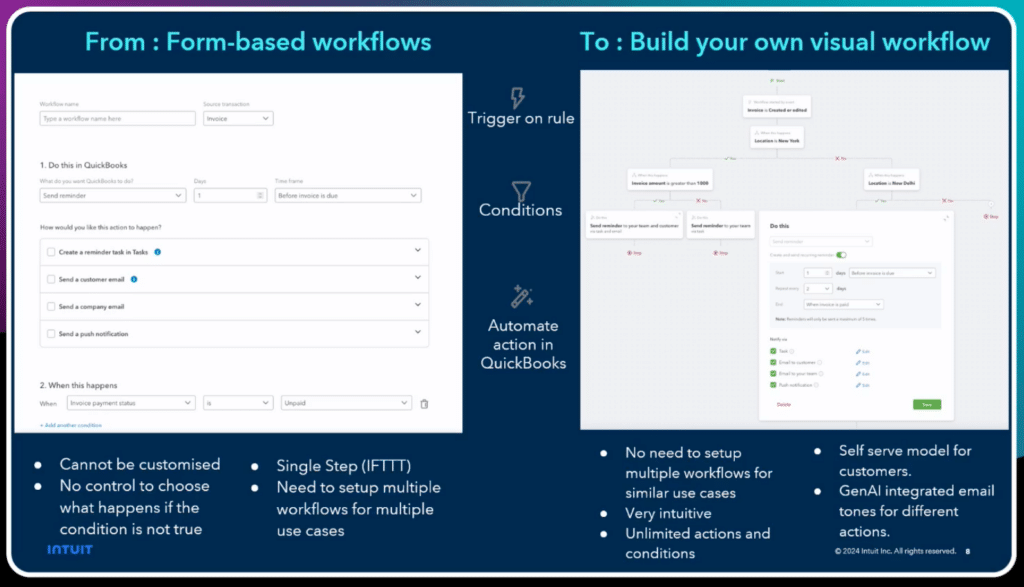
Workflow innovations at Intuit
“We specialize in small business and midmarket businesses. As they grow, they need to put a lot of time and money into customizing business processes.” Workflows can automate part or all of those business processes. “That’s the whole idea of why my team exists,” Surana said.
“Let’s take a customer problem,” Agarwal said, taking us into a use case for workflows. “No one wants to get paid late, right?” He walked us through a form-based workflow and the rules that might trigger it and the conditions that happen when conditions are met. Intuit was able to simplify this workflow into a build-your-own visual workflow with essentially infinite variables, so customers would not have to wait for Intuit to push out more templates.
Customers are now able to send invoices faster and pay their vendors faster. “But it wasn’t easy to get there,” Agarwal said. “So how did we do it?”
First, ensuring customizability and reusability. Second, the DMN Compiler that simplifies rule evaluation and nudges customers to avoid redundant workflows.
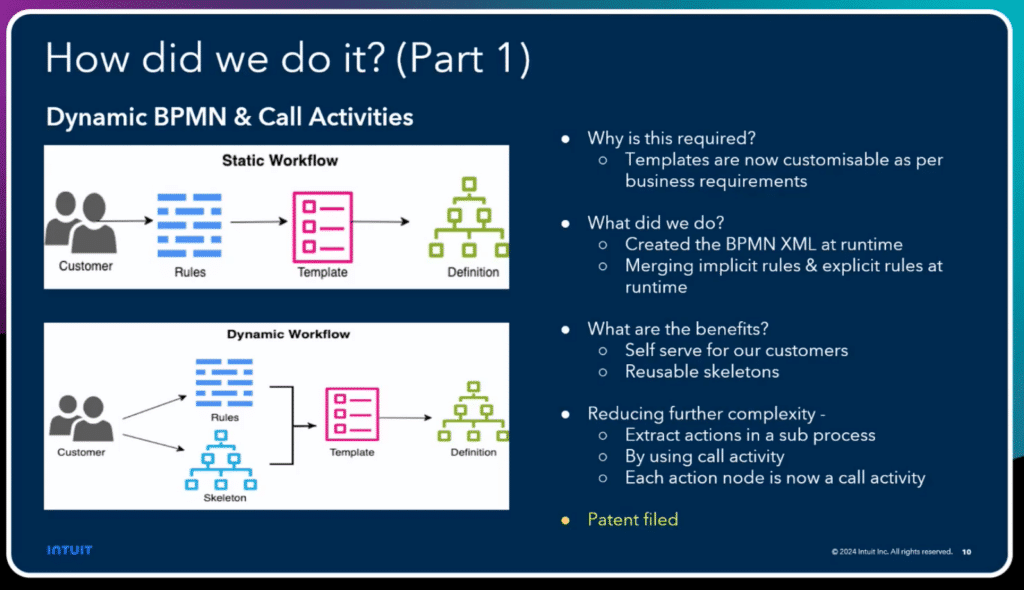
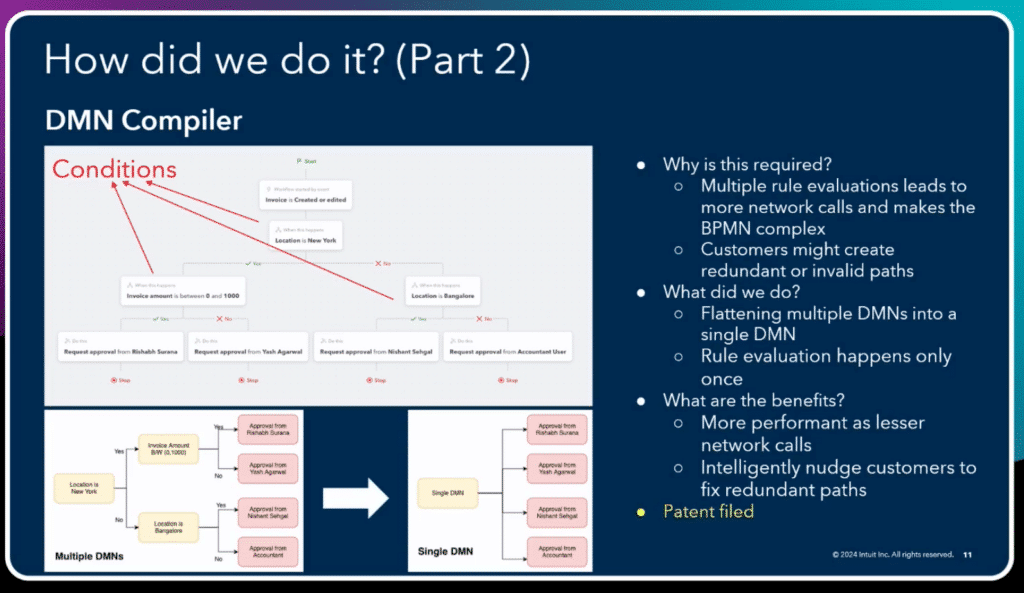
Scaling existing infrastructure with Camunda
With 1.5 million workflows executed per day, they faced scaling issues while on Camunda 7. Bottlenecks included external tasks, timers, and job creation. To handle these issues, they avoided timer jobs, distributed timer load, and moved from pull-based to a push-based framework.
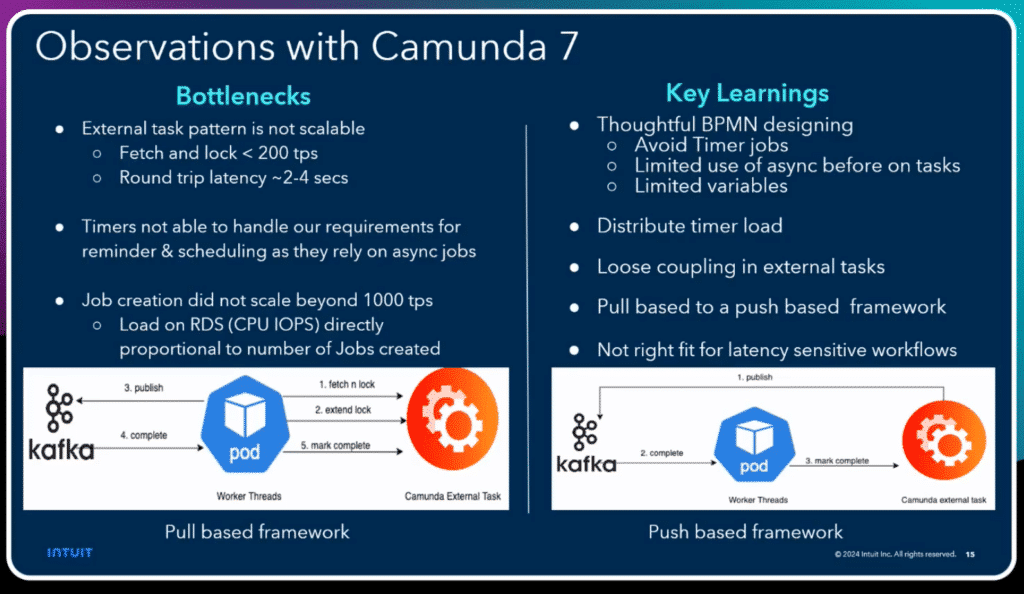
Challenges with Camunda 8
Working with Camunda support, Intuit figured out how to tweak CPU IOPS, throughput, and memory per pod. “We might be able to scale infinitely with Camunda 8,” Agarwal said.
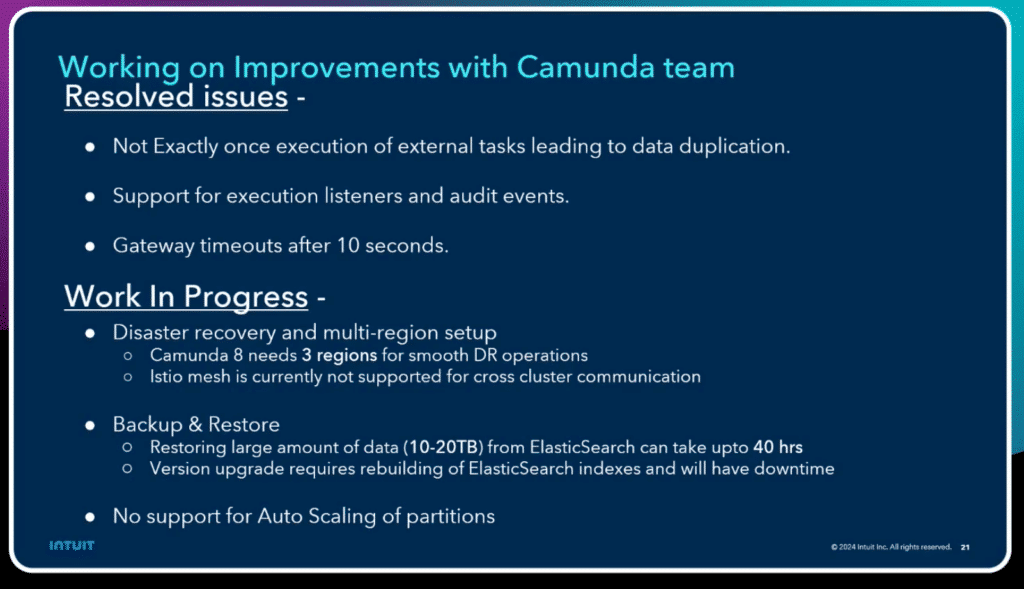
ICYMI
- Just before the above on the Purple Stage, Pavel Kotelevskii led a session on Inbound Connectors: Real-World Challenges and Solutions. In this packed session (seriously, people were standing), Pavel shared the latest on Camunda’s inbound connectors, showcasing practial moderling patterns and getting into the details about best practices for tackling consumer deduplication, message acknowledgment, and error handling. Don’t miss it.
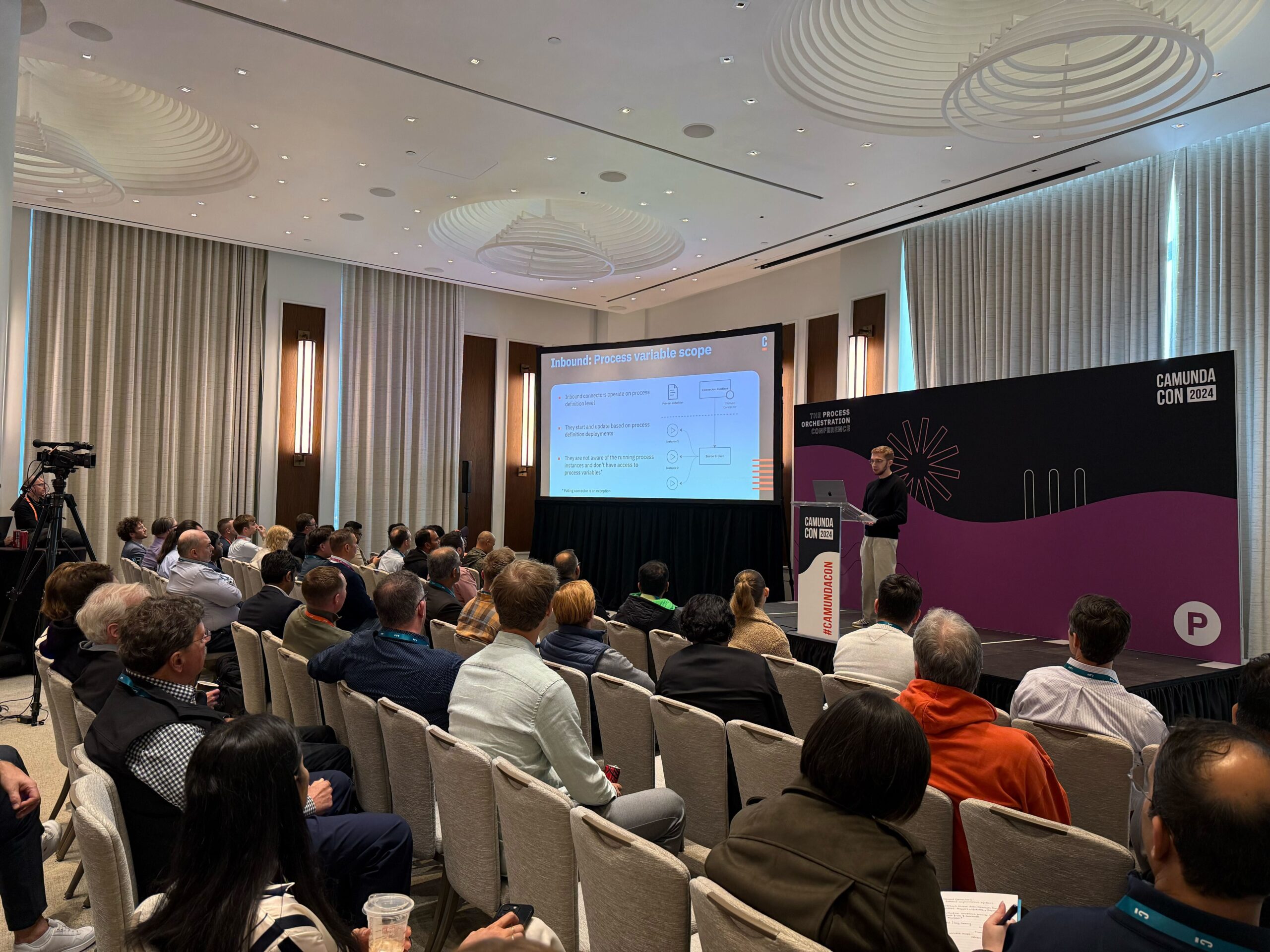
- Over on the Orange Stage, Scott Wilger (Senior Director of Business Architecture, Field Operations, Charter Communications) and Sergiy Tsymbal (Software Engineer, BP3) led a talk on Revolutionizing construction: Charter Communications’ path from engineer-to-order (ETO) to made-to-stock (MTS). They shared how a a focus on the user experience, standardization and automation let Charter Communications implement its next-generation construction management system. See how they did this while employing cutting edge technologies such as Camunda, BPMN, DMN, Kafka, and Kubernetes.
Optimizing the pharmacy ecosystem with APIs, microservices, and workflow automation
This main stage session opened up with a story. Sudipto Dey, Senior Principal at Cigna – Evernorth, share the story of John, a cancer patient. He manages his prescriptions through Cigna, and until just a few years ago, when an issue or unexpected change came up, it would take Cigna 6-7 days to communicate with his doctor about that change. Today, it takes just one. This, Sudipto said, gives engineers a sense of pride and accomplishment, to be able to help.
Roberto Camara, Senior Software Engineer at Cigna – Evernorth, remarked on how everyone can appreciate that story, asking the audience to raise their hands if anyone had ever had their prescriptions delayed. You can imagine how many hands went up.
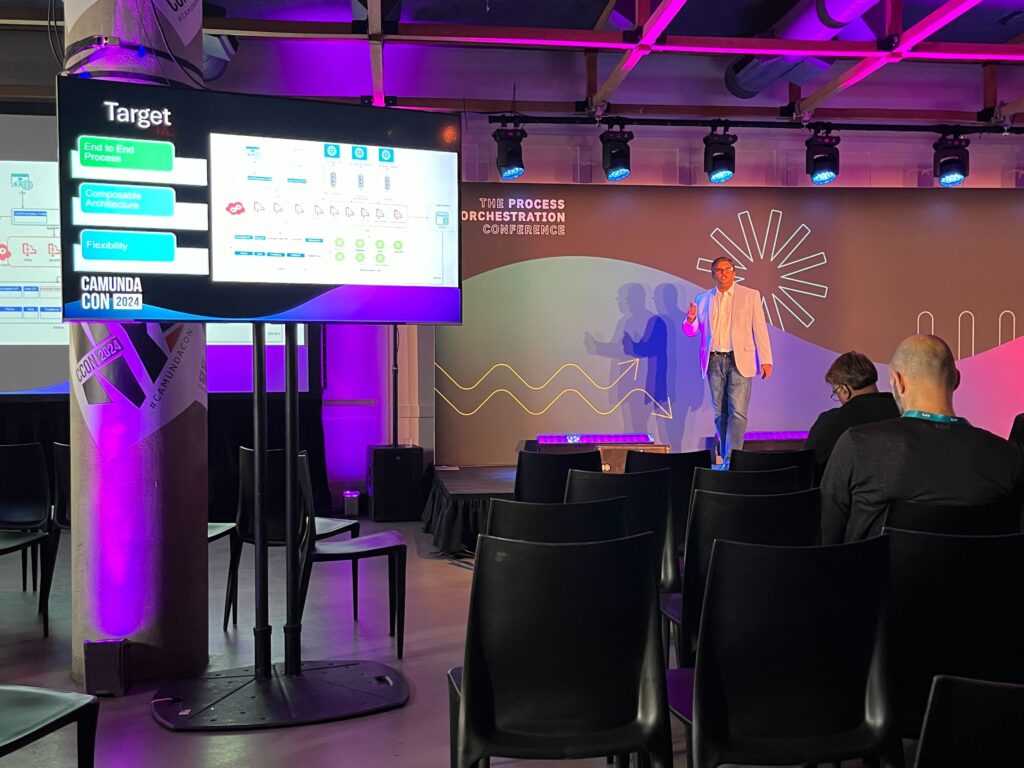
Sudipto covered the complexity of their world today, including a number of systems they need to interact with, and legacy infrastructure that must be maintained. He noted that one of their biggest accomplishments has been to enable end-to-end processes. Sudipto emphasized that means truly end to end – from the very beginning (ie: prescription ordered) to the very end (prescription delivered), all orchestrated in one place. Sudipto pointed out that Camunda met this need better than anyone else, delivering unparalleled composability and flexibility.
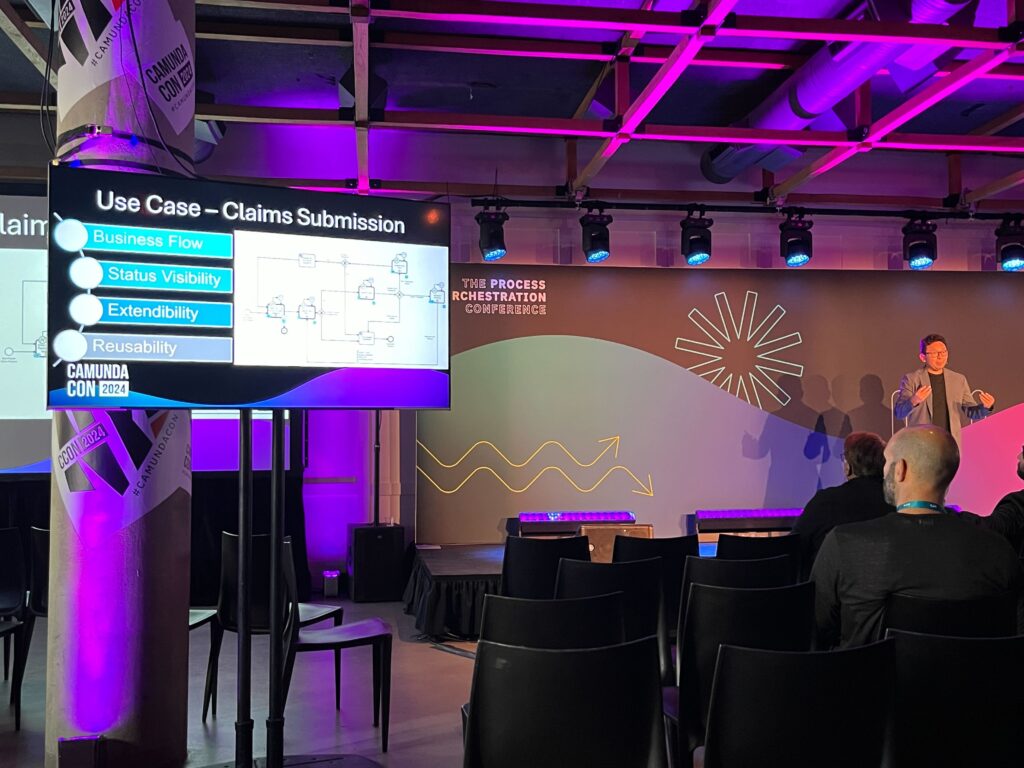
Next Roberto walked us through a few specific use case examples, including a claims submission process and a Biosimilar process. He described their requirements and what they knew they needed to get out of any orchestration platform. Visibility, reusability, composability and flexibility were key requirements. Again, Camunda was a perfect fit. The ability of the platform to change, adapt, and retry adds tremendous value, and “when we can say yes, it can do that,” it builds trust within the organization that the platform works for them.
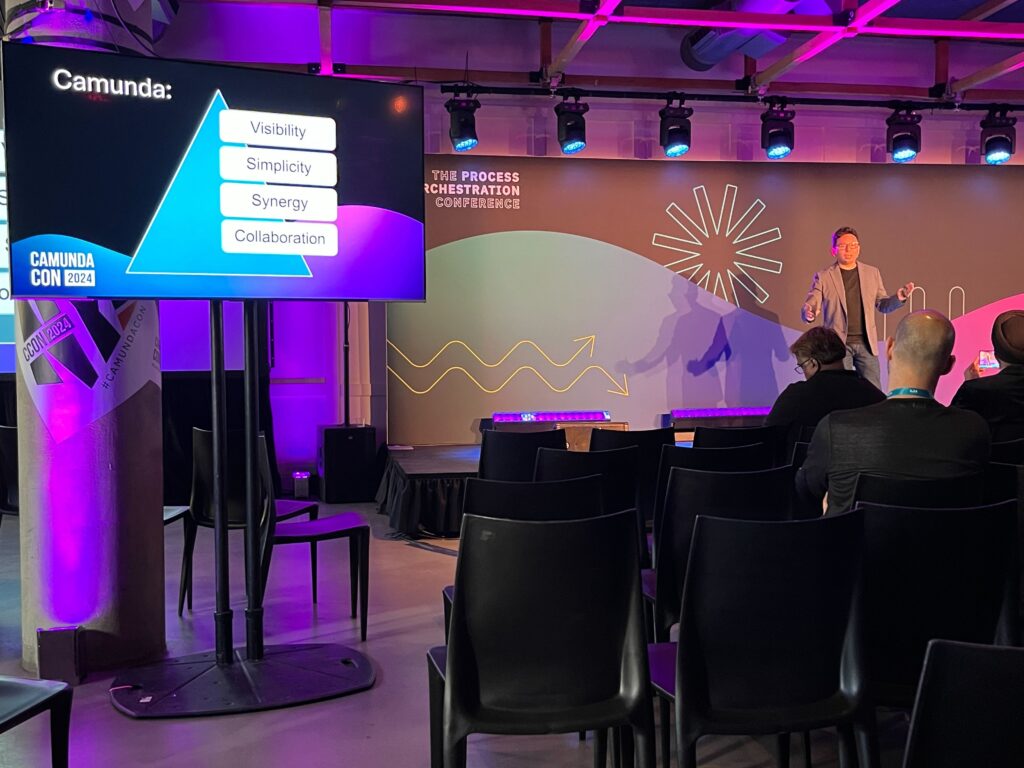
Healthcare is a complicated but critical industry, and it was really interesting to get this look into the way process orchestration can make a real impact in the health and quality of life for people everywhere. Be sure to check out the recording to see all the details and watch the Q&A.
AI as the next UI: Driving intelligent straight-through processing at Infosys using Camunda
On the Orange Stage, Bhupesh Naik, associate vice president of business at Infosys, took us on a journey into the future with technology that’s available now.
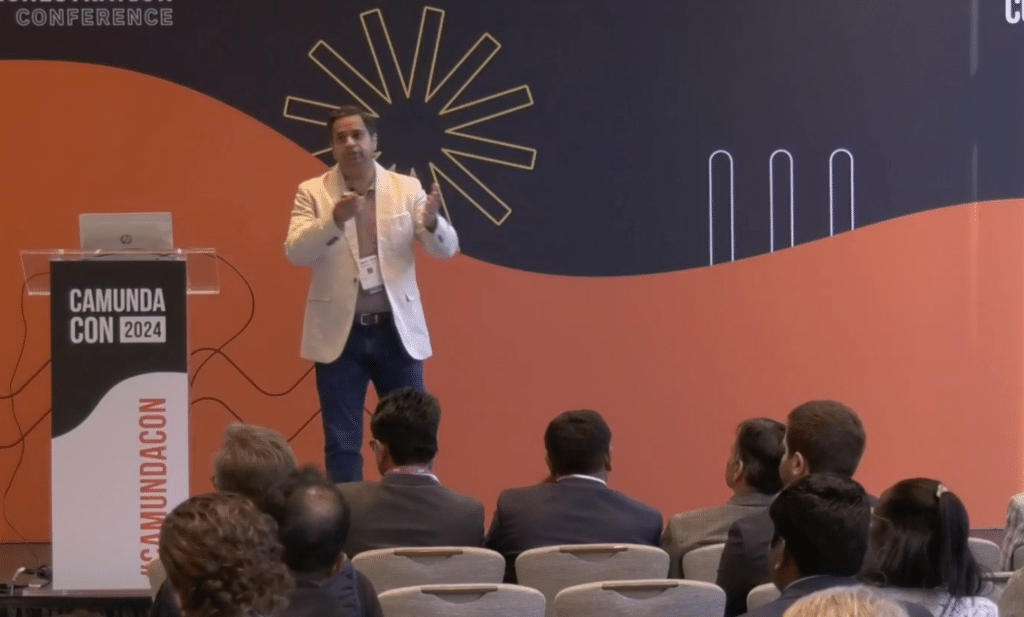
“It may sounds like sci-fi now, but I think this is the way technology is going to move,” Naik said. AI-infused systems will look different than the typical multi-screen workflows end users have worked with for years. “You don’t need human interaction to make every decision. AI will take the front seat. We’ll see machine-to-machine prompts without a UI.”
To demonstrate his point, Naik showed us a typical system interaction for an international banking transfer as you would probably experience it now—with, say, nine different screens and 10 clicks and countless keystrokes. “Instead, we should be challenging our engineers to make something conversational,” Naik said. “With AI, we can take out multiple UIs, make sure the lead isn’t lost, and make sure the lead is closed.”
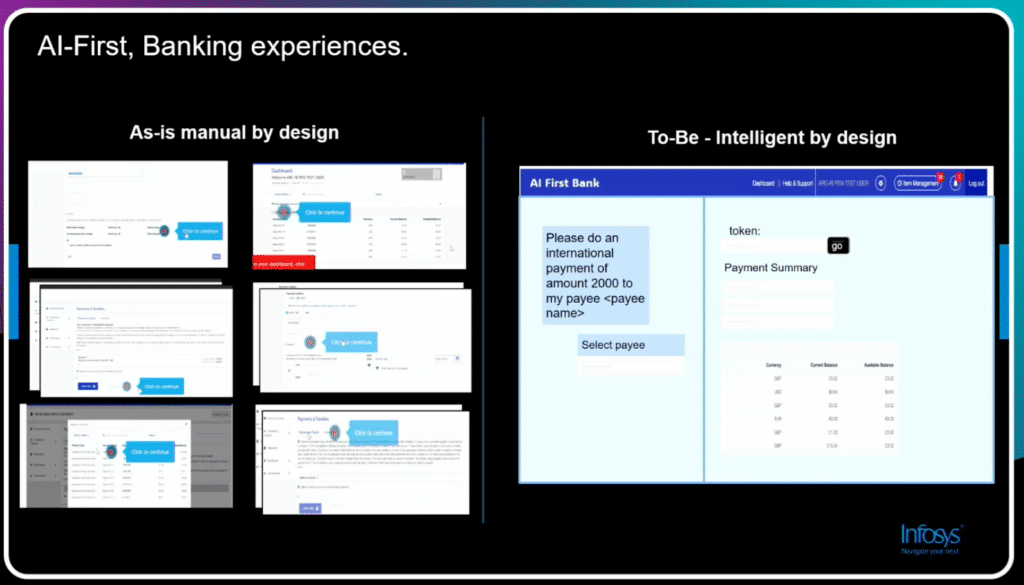
Naik is well aware that his passion for AI is obvious. “I would be challenged if I said AI is the new code,” he said, then added with a shrug, “Although someone on Twitter said the new programming language is going to be English.”
Demo with Camunda
Naik took us through a short demo for filing an auto insurance claim. “We’re fast-forwarding this part because I don’t like it,” he said with a groan. “J ust the clicks and keystrokes and screens. We’ve been doing this for years, since I learned how to use a PC.”
Instead, Naik focused on a part of the demo where a user speaks directly with an AI claims agent via one screen. AI tools were able to make multiple data decisions, such as using image analytics to document damage photos uploaded directly into the conversation.
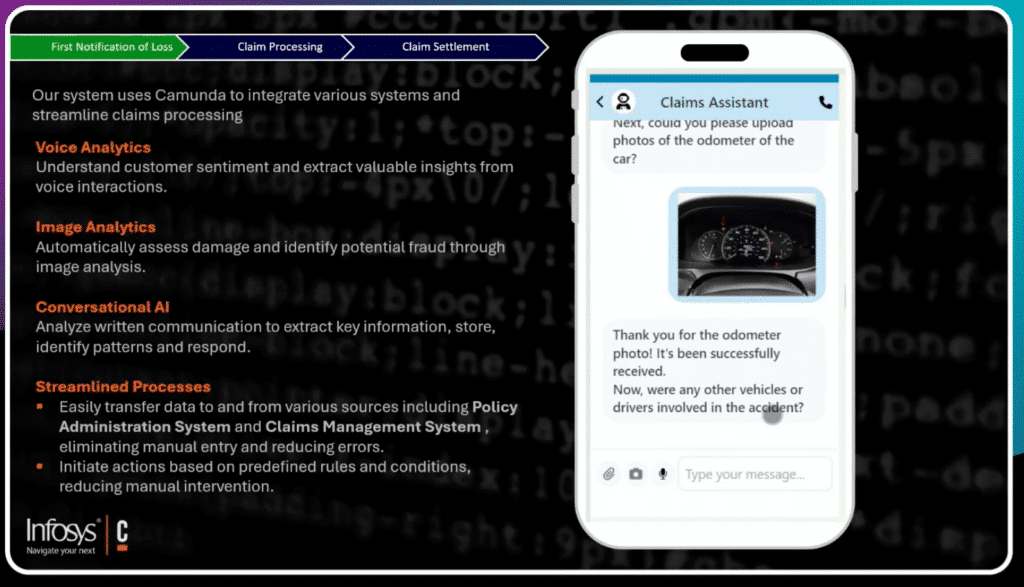
“All this is happening with two key capabilities,” Naik said. “Conversational AI and streamlined processing.” Some dashboard is still required for the human agent, but overall the number of screens engineers must build are greatly reduced.
“You have fewer steps, fewer actions,” he said, leading to a system where the agent is making decisions, not driving data aggregation.
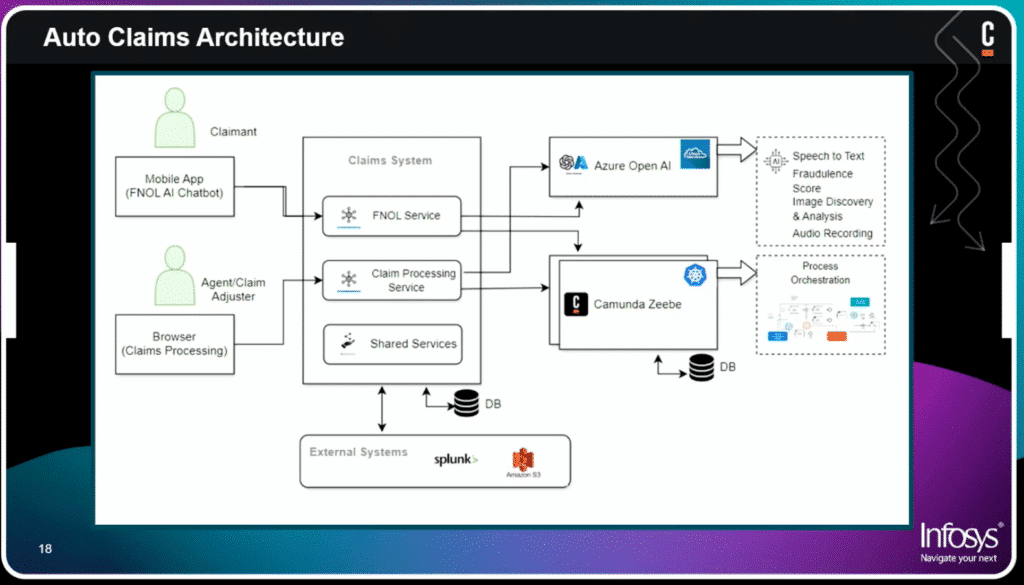
Taming complexity: How BeOne uses dynamic DMN rules generation for tax regulations
We all know tax rules are complex. BeOne is the leading company using Camunda in Poland, with hundreds of thousands of businesses using dozens of their ready-to-use process orchestration process templates. They knew this was a kind of complexity that process orchestration could solve. And so, as Marcin Makowski, Enterprise Architect at BeOne, and Jerzy Mikosz from Robotic Ledger explained: they built Luca.
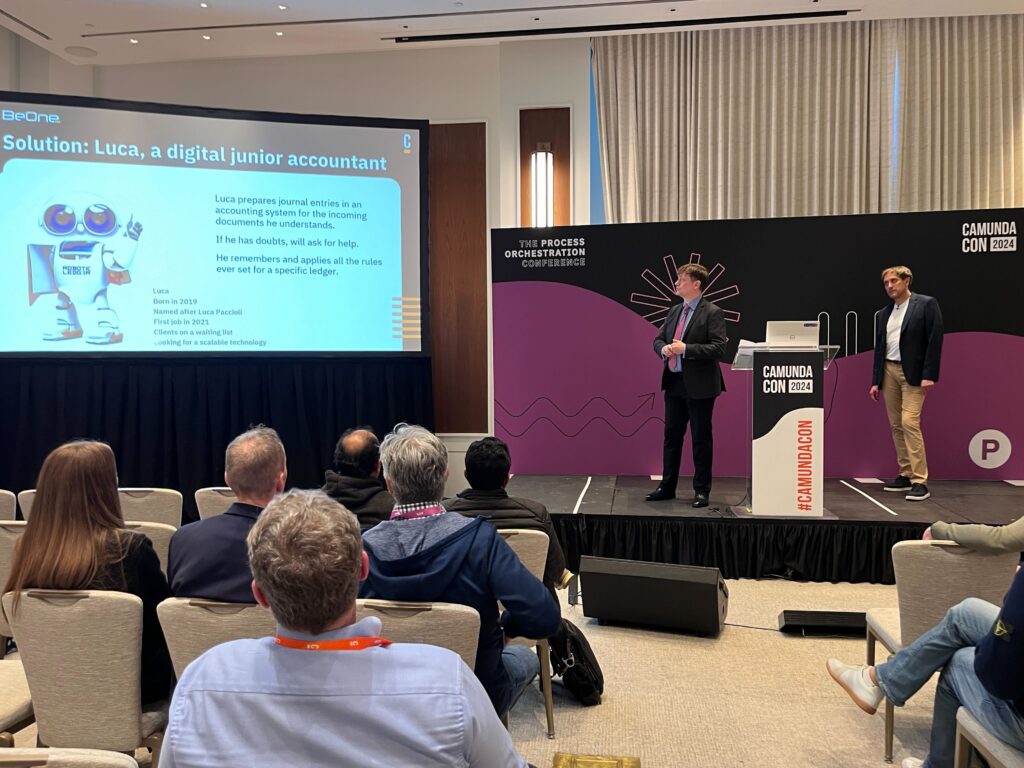
To automate something as complex as tax regulations, first unstructured data needed to be classified and understood, and then turned into structured data. BeOne implemented this through DMN, which will be, supplemented by manual classification. This would allow, over time, a source of tax answers to be collected – especially by a community of users – that is superior to Google or ChatGPT, because it’s manually added by experts into a closed and secured model. Gradually, Luca should be able to do more and more autonomously.
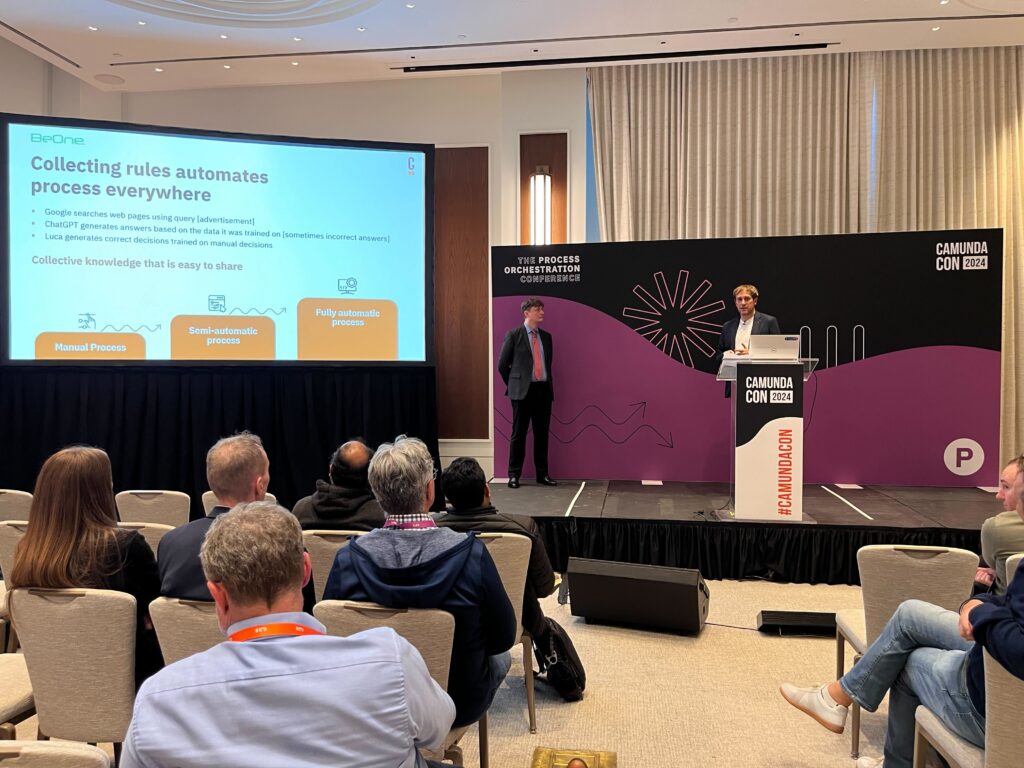
They emphasized that building solutions for communities is different than doing it for organizations. But this kind of self sustaining decision model is a natural way of collecting professional knowledge, which is critical for making decisions or automations. And if they get this right, there is a massive opportunity ahead for helping businesses fill professional forms.
This was an interesting use of Camunda and dynamically changing DMN to create an ever more sophisticated set of rules – dare I say it’s a bit like creating an AI? – to solve a specific and business-critical problem.
US Bank: Camunda case management with microapps
Prashant Appikatla, a software engineer at US Bank, spoke from the main stage about the unique problem of creating templates for microapps that different business lines can plug into their own implementations.
“You can have Camunda orchestrate your microservices,” Appikatla acknowledged, “but it does create tighter coupling. If one of your microservices is down, your process has stopped.”
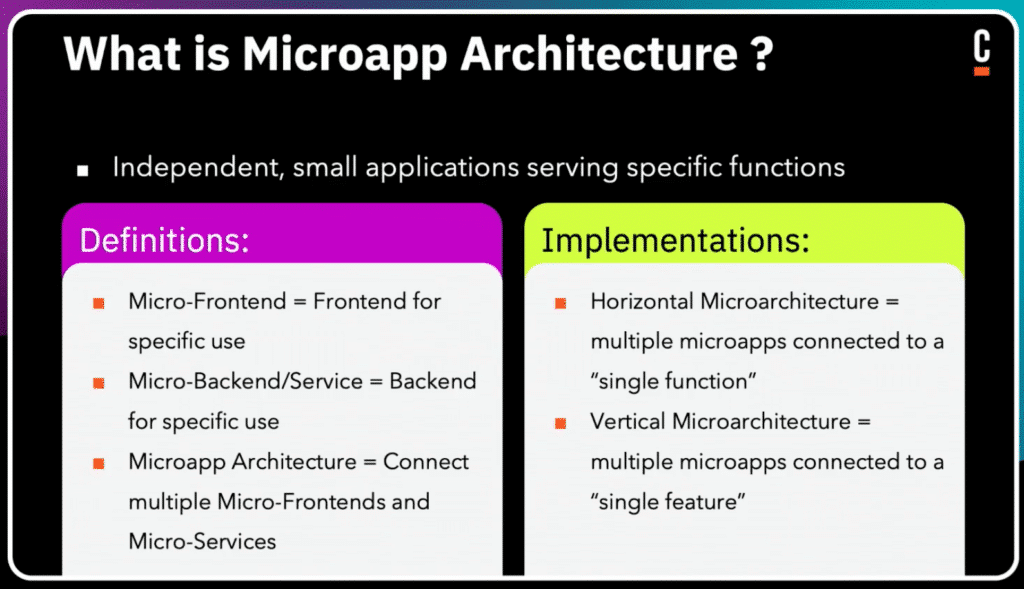
Most of the business teams that come to Appikatla are looking for new applications they need to build. “They have use cases but no existing tools. Or they’re taking one of our legacy systems and trying to break them down.” Those teams can pull templated microapps into a sandbox environment and get started with Camunda as quickly as possible.
“We’re trying to create small workable services where we can collaborate with existing lines,” Appikatla said, “without our team having to manage and deploy.”
Demo
Appikatla braved a live demo of a mobile payment app that was running five microapps together with a total of eight packages. He walked us through a customer dispute, which went through decisioning and finally to a fraud specialist. “As you move through the process, you migrate from one microapp to the next,” he explained.
Challenges
As with any system, microapp architecture has its challenges. “We’re trying to find a way to maintain data consistency across all these microapps,” Appikatla said, “and CI/CD has also been a little bit tough.”
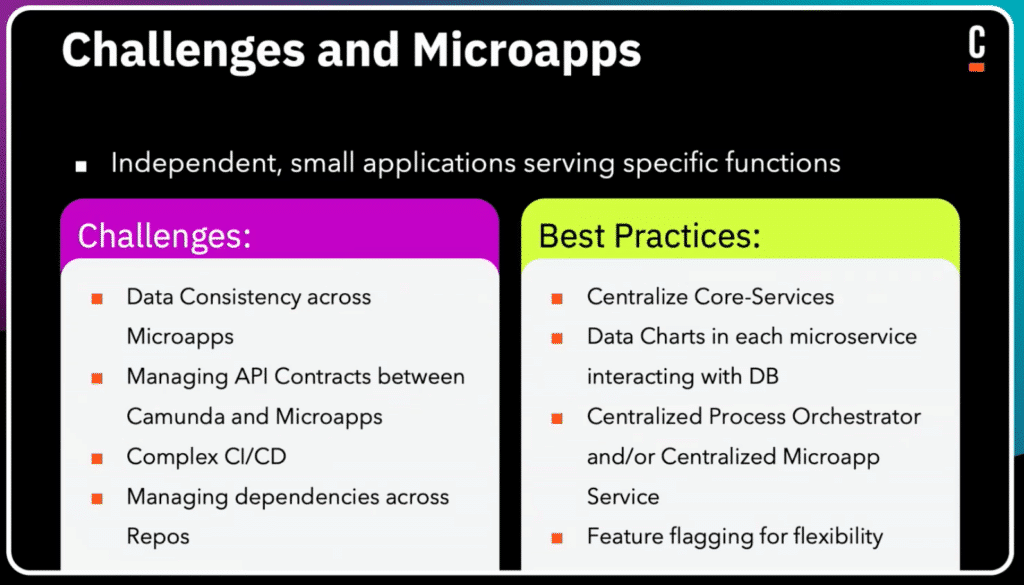
ICYMI
- A bit earlier on the Purple Stage, Falko Menge, Senior Principal, Solution Architect at Camunda, led a session on The State of Performance. In this session, Falko and the Camunda consulting team show how they simulate real-world workloads to push the limits of what the Zeebe engine can do. Catch this one to see how Camunda stays inspired to keep improving performance so that they can always serve their customers, no matter the quantity or duration of the process instances they require.
- The Hackday Presentations also took place around this time over on the Orange Stage. This was a fun look at what teams of developers could accomplish in just one afternoon. Below, find a process that was built that can help you plan your birthday party ????
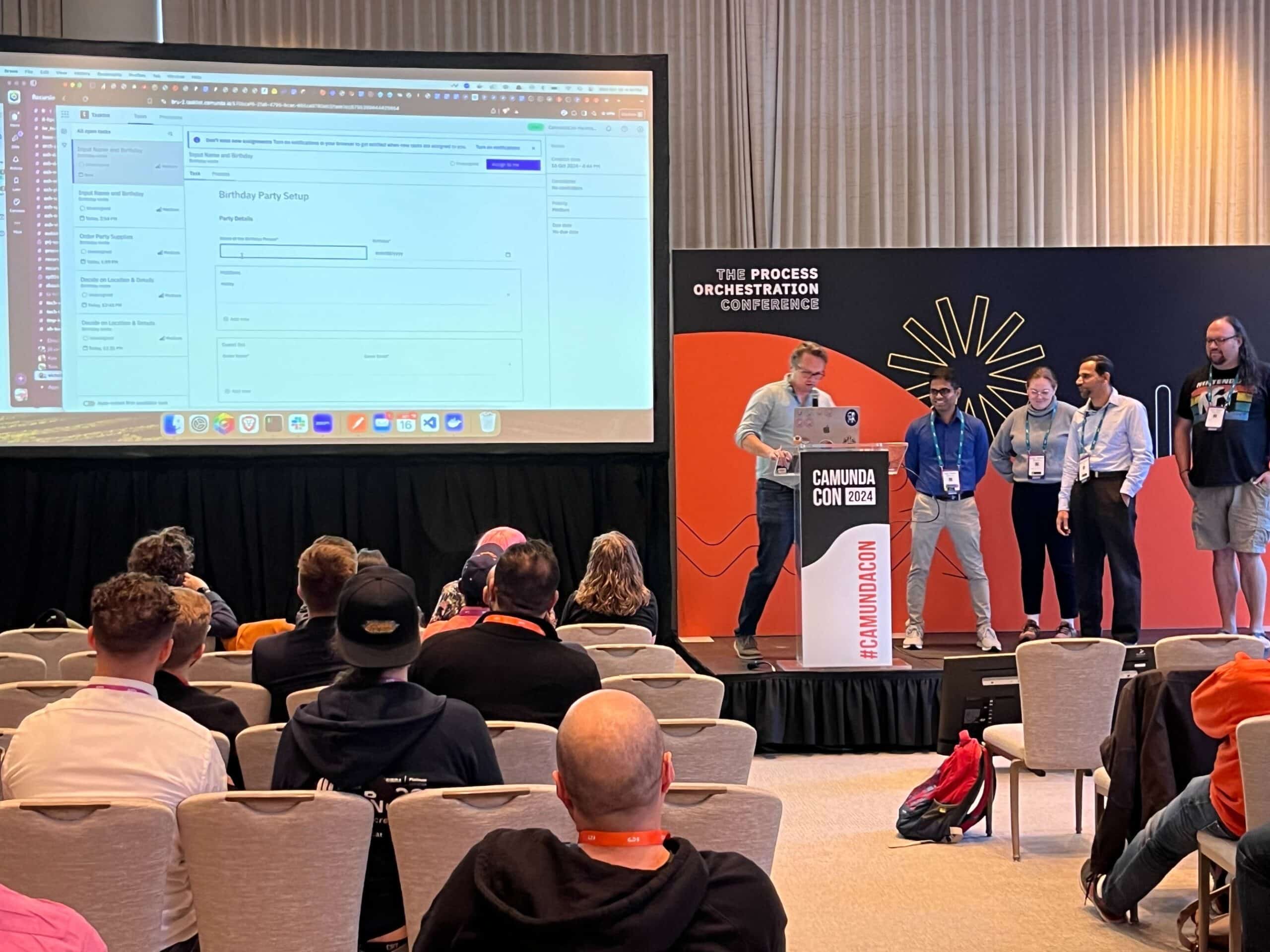
- This afternoon, Camunda also had a series of Industry Roundtables going on by the Green Stage. This was a unique opportunity for our in-person attendees to have industry-specific conversations with other attendees in their industry as well as Camunda professionals.
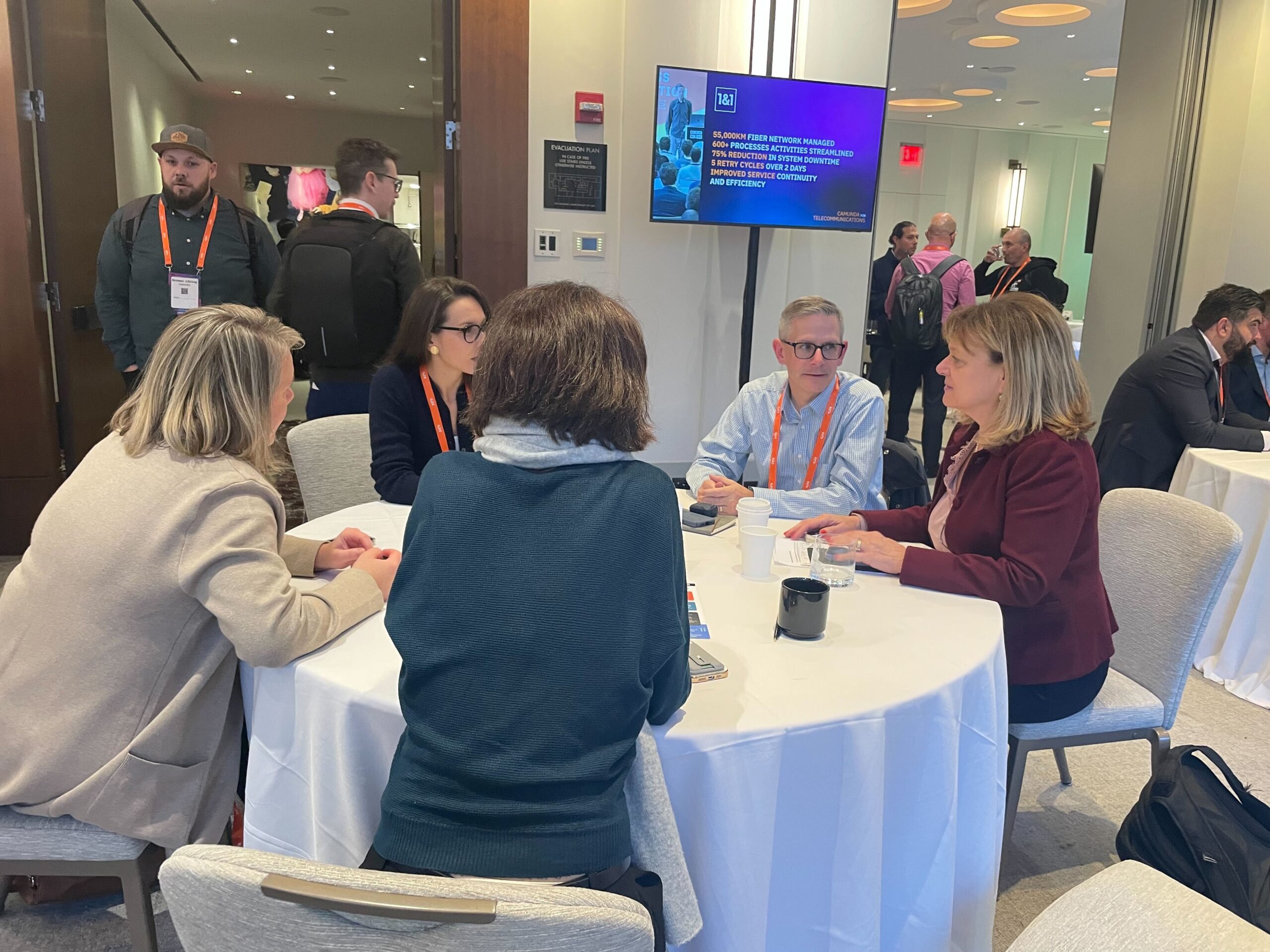
Bridging the Enterprise Gap: Integrating Camunda and SAP for Efficient Process Orchestration
Back in May at CamundaCon Berlin 2024, Volker Buzek co-presented on the work being done to drive increased business value from an SAP environment at a large car manufacturer. This was incredibly successful, reducing errors on that process through automation basically to nothing. Not only that, but it sped up the process and produced many other benefits.
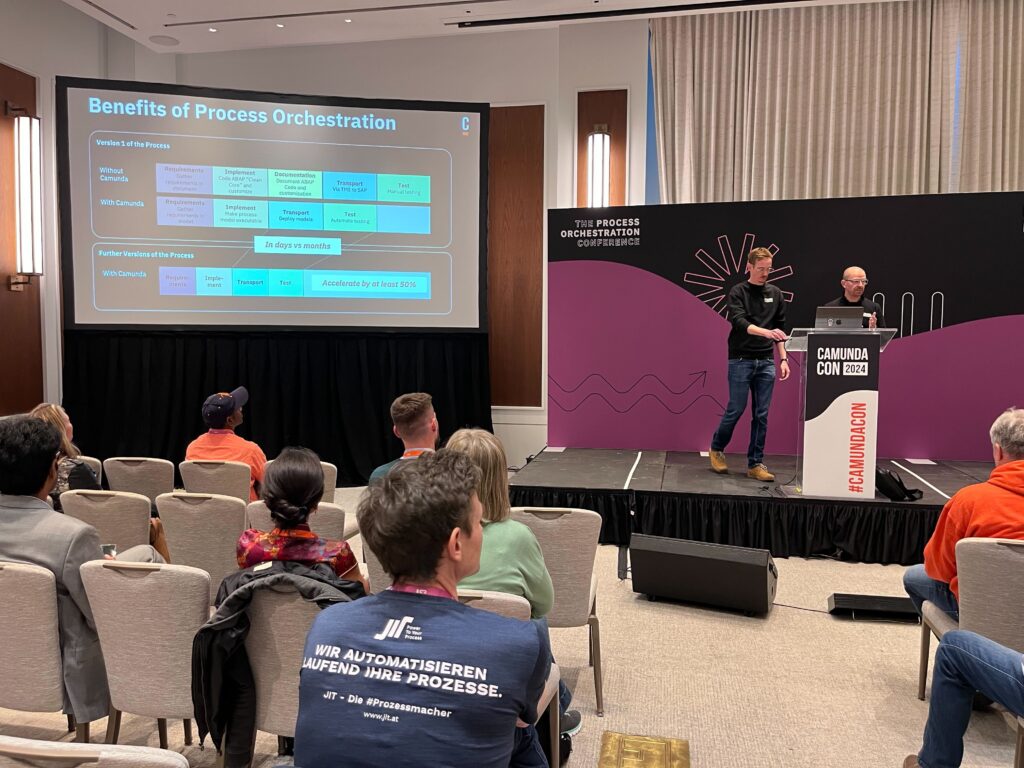
But this was just scratching the surface. Today, Volker works for Camunda as a Senior Consultant, and along with Tobias Conz, Senior Product Manager, presented on the future of Camunda and SAP. Camunda and process orchestration can play a hugely beneficial role when more visibility is required, when processes are long running, and when scalability and flexibility are critical, adding significant value to existing SAP processes.
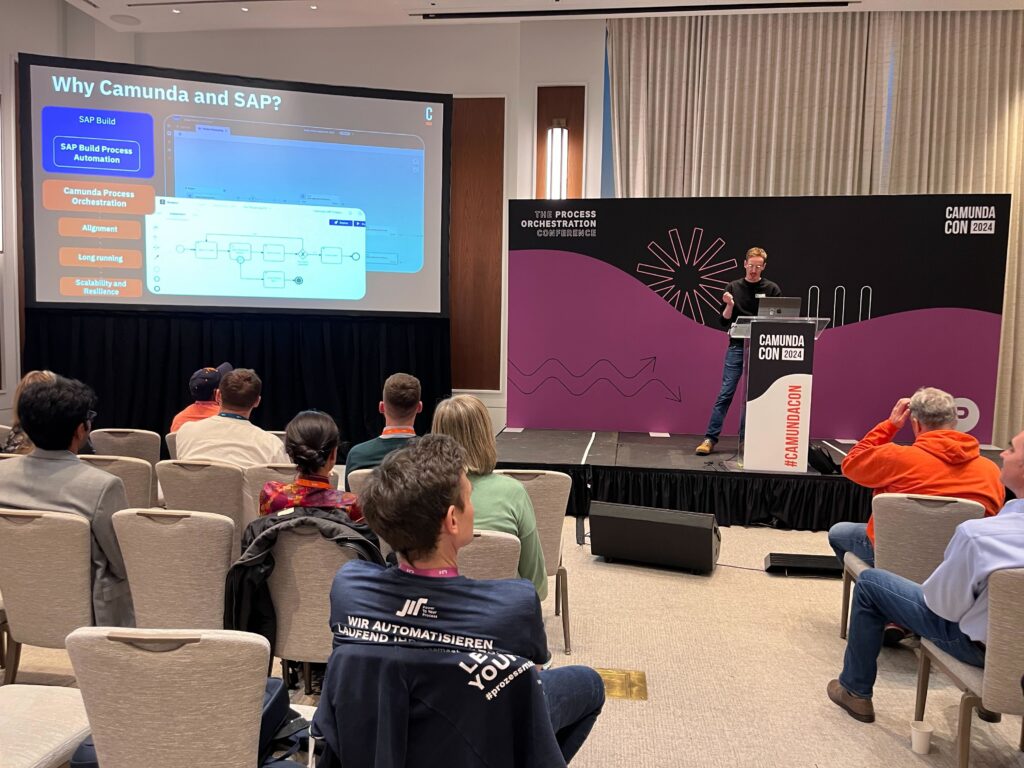
Next, Volker presented a live demo of how this could work. He showed how you can call any OData API on S4 or ECC from Camunda Modeler. Just like that, you can connect your BPMN and your SAP processes in either direction. “How does this sound?” Volker asked. “Really boring. And that’s what we want. It should just work.” With no code, partners and customers can now build templates that connect to SAP. Volker went on to show other functionality, including the ability to render Camunda forms in SAP Fiori.
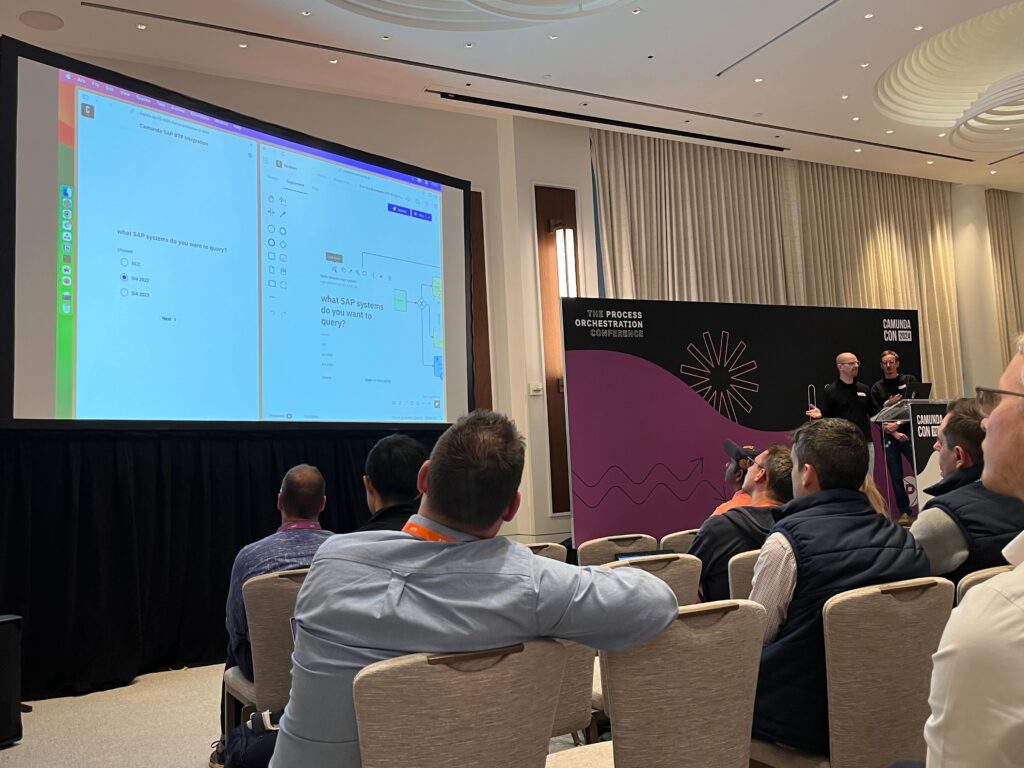
Tobias concluded the talk by talking about key use cases, including the upcoming S4HANA migration, industry-specific flexible business solutions, and end to end process orchestration that includes SAP. He reminded the audience that general availability should be here with Camunda 8.7, coming in January 2025.
Be sure to catch the full recording as well as this blog post for more information on this powerful and boring (in an exciting way, if you will) new capability.
Panel: Accelerating the business value of transformation in banking and financial services
The final panel of the day took over the main stage with panelists Michael Goldverg, managing director at BNY; Parul Ghosh, executive director of engineering enablement at Wells Fargo; and Min Tha Gyaw, chief strategy officer at Mifos Initiative. Sathya Sethuraman, field CTO at Camunda, moderated. These executives put their heads together to discuss transformation trends in banking and finance, and how their individual organizations have addressed those changes.
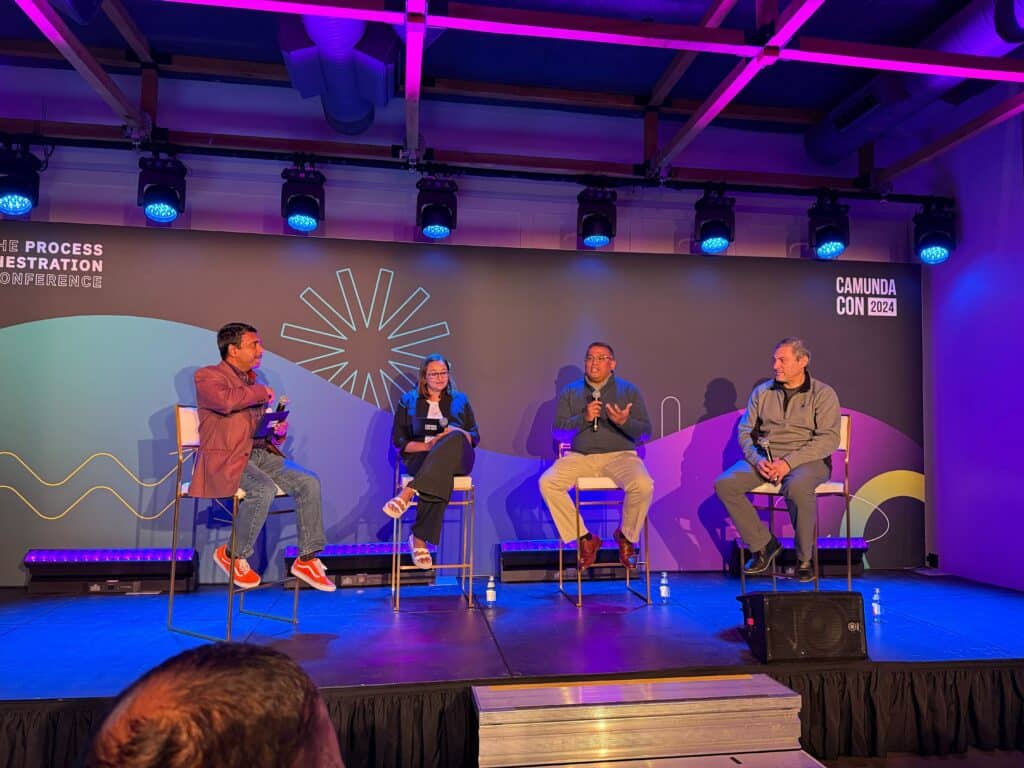
Sethuraman opened with a comment on the diversity of the panel, including how different financial types of businesses were represented from fin tech to an emerging country open-source banking nonprofit.
What are some key drivers of finance sector trends?
“Making the customer feel well is one of the key drivers of trends today,” Ghosh said. “If you don’t make them feel special, they can hop over to someone else.” However, regulatory compliance keeps banks from iterating too quickly. “Both EU as well as US have guidance coming in about AI as well.” A third driver is geopolitics. “Banks are more worried about that than inflation,” she added. And then, thanks to ever-evolving technology, banks also have to constantly upskill people.
“Those are trends for larger banks for sure,” Sethuraman said. So how do they affect smaller banks?
The tech industry faces significant changes more often, Min Tha Gyaw said, so the likelihood of crises has gone up significantly in the last few years. And crises are always drivers for change. “But also technology has gotten more affordable. It’s easier for smaller institutions to make those changes.”
“There’s more and more demand for resiliency,” Goldverg pointed out. “Cybersecurity is getting more and more complex.” And of course, whether AI is good or not, “it’s too early to say.”
Still, it’s easier than ever to adapt to new challenges, Min Tha Gyaw said. “It allows you to address things quite quickly.”
Ten years ago, month-long development cycles were typical. Not now, Goldverg said. Weeklong dev cycles demand other solutions for quality control and security.
What are new initiatives you’re seeing in the industry?
“Regulators having more openness to new technologies.” Min Tha Gyaw acknowledge that most financial organizations think cloud-based is still too risky, but it would help transformation in financial industries.
“Fintech used to be spoken of like a threat,” Ghosh said, “but there’s a lot of symbiosis now, with things like Stripe and GS working together. This will really change how we deliver solutions to the customer.”
Goldverg highlighted cybersecurity as a hot initiative in finance. “Previously, cybersecurity was considered a perimeter around the organization. But a few years ago, companies realized there will always be holes. Instead of securing walls, now we need to secure everything within the organization. It’s a lot more work and takes a lot more education.”
“And AI is touching all of this,” Sethuraman added.
Goldverg noted that 2024 seems to have been a turning point for the usability of AI. “We’re seeing more and more practical applications of it.”
What are the major challenges currently?
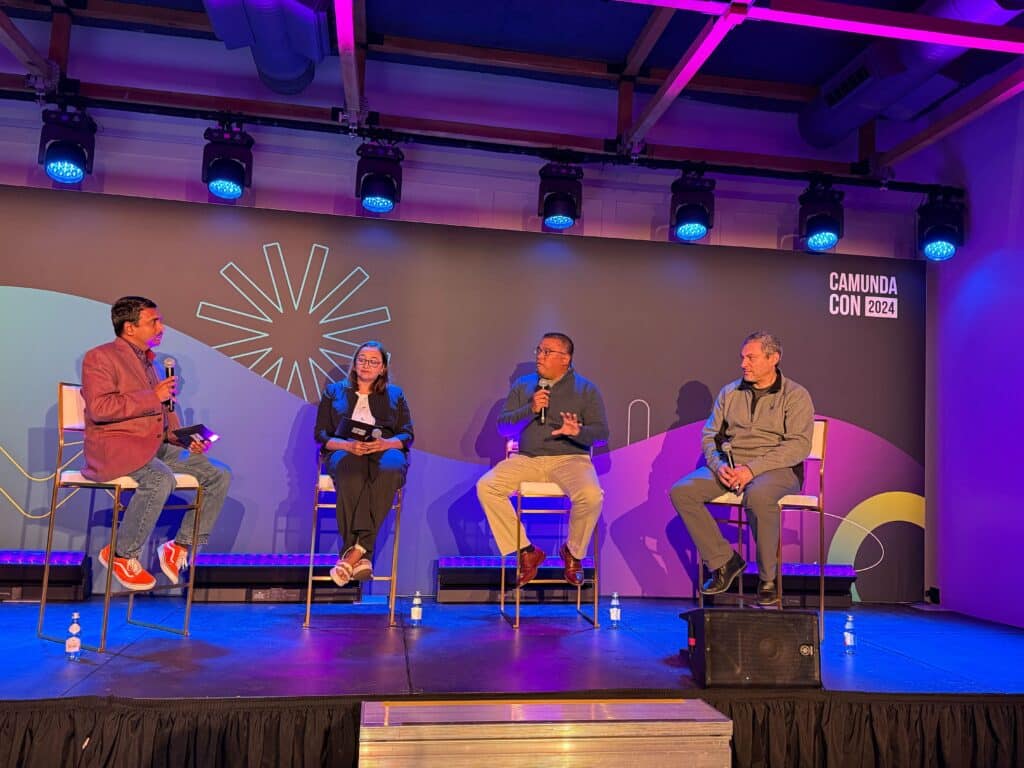
Ghosh pointed out the question of build or buy when it comes to technology solutions. “A bank’s purpose is to help their customers. So is it worth it to build the solution yourself, or should you partner with someone who’s already build the solution?”
“It’s not an easy question,” Goldverg agreed. As a developer, he likes to build. But as a business leader, is it efficient to recreate something that’s already been made? “But you also have to consider how difficult it will be to integrate an external solution into your system.”
Figure out what you can’t compromise on, Min Tha Gyaw suggested. “Buy everything else. Decide who you are—are you a technology company, are you an investment company, are you a risk management company—and make your decisions based on that.” Although that self-understanding can be difficult to grasp when leadership changes direction after hearing a buzzword at a meeting.
Goldverg cautioned against choosing speed over quality. “If you start ignoring the quality of the product, your speed gain will be temporary. More likely than not, you will slow down no matter what. My firm belief is investing in quality is paramount,” Goldverg said. Investing in sales and branding may be important, but “It’s not the slide deck that fails in production, it’s the software.”
“One hundred percent agree with you,” Sethuraman said.
Aftershow and Networking Reception
We’ve reached the end – what a day! For those in person, it’s time for a networking reception where you can connect with other attendees, Camundi and partners. For those at home, enjoy your evening! Be sure not to miss all the amazing speakers and activities tomorrow, including keynotes from Bernd and Daniel and from Craig Le Clair of Forrester, our always popular Unconference, a book signing for Enterprise Process Orchestration, a morning run with Bernd and more.
See you then! ????
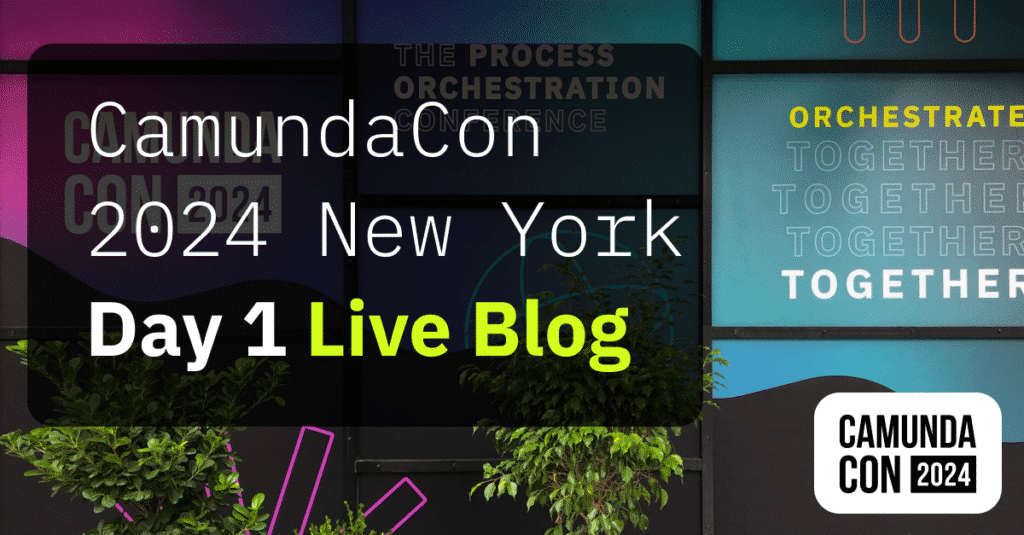


Start the discussion at forum.camunda.io